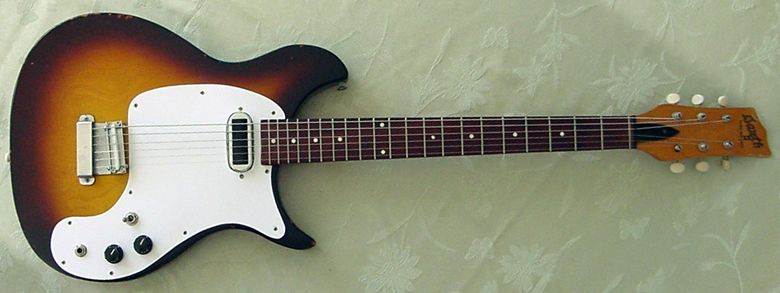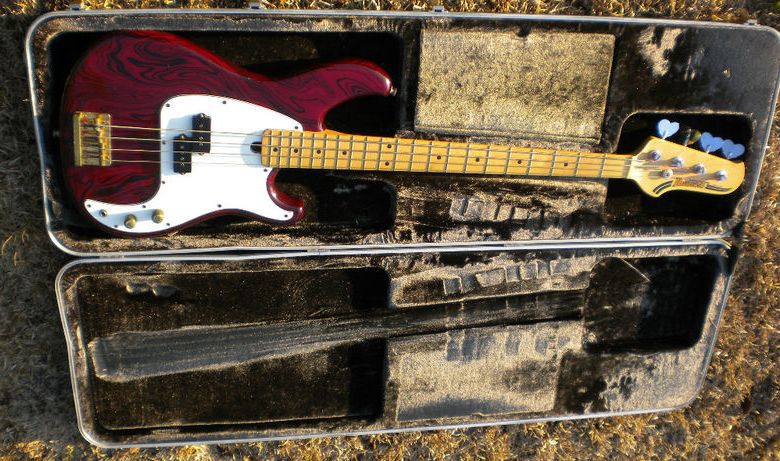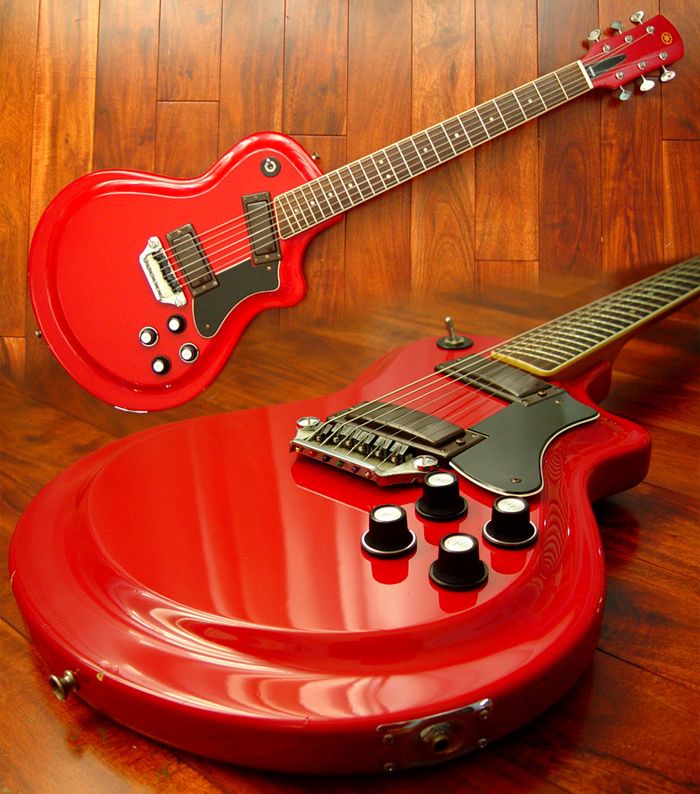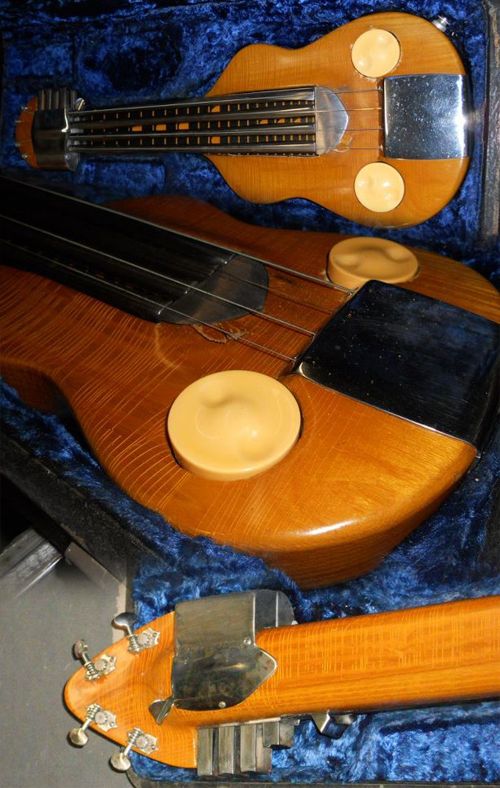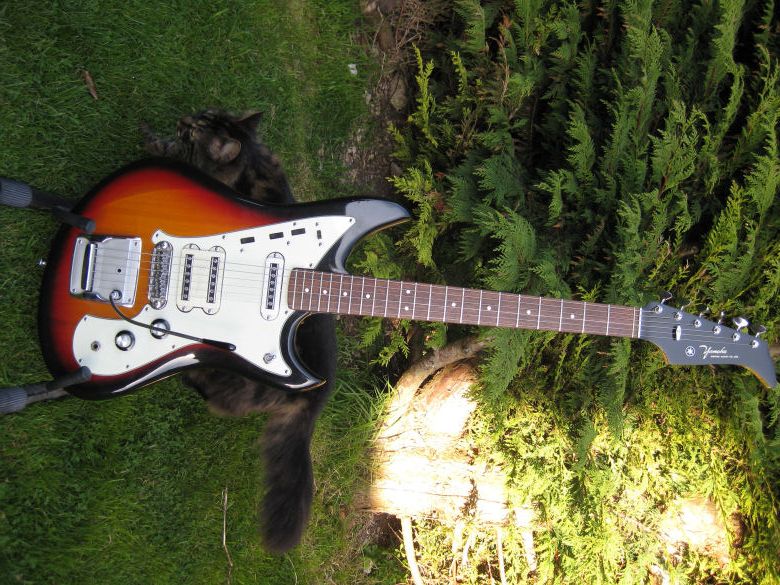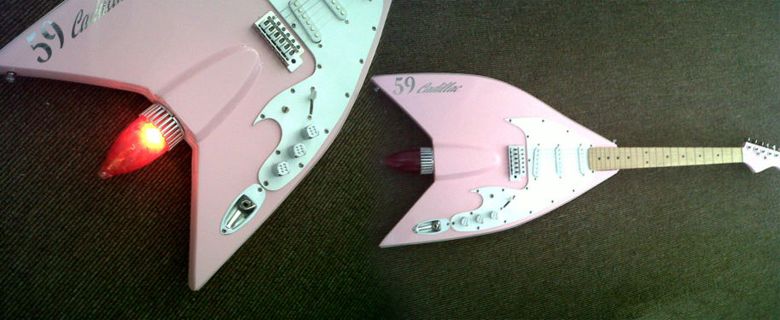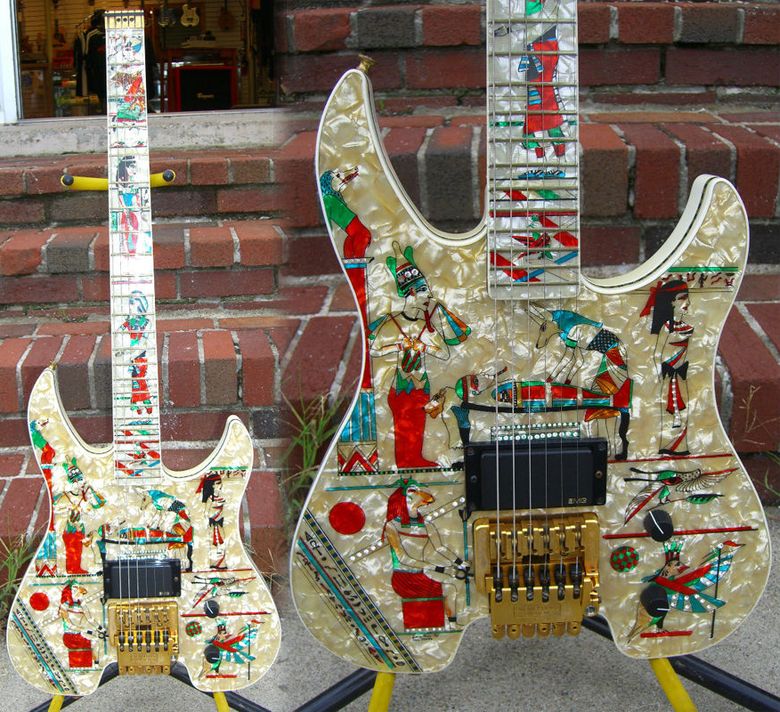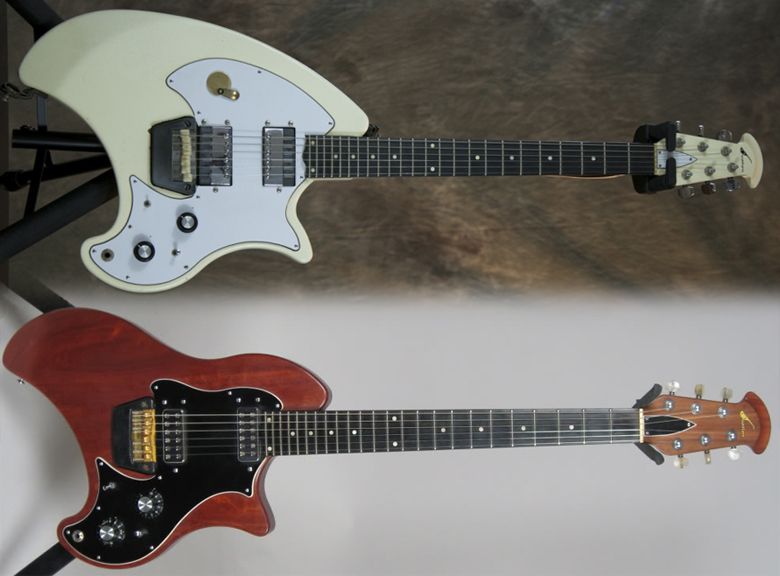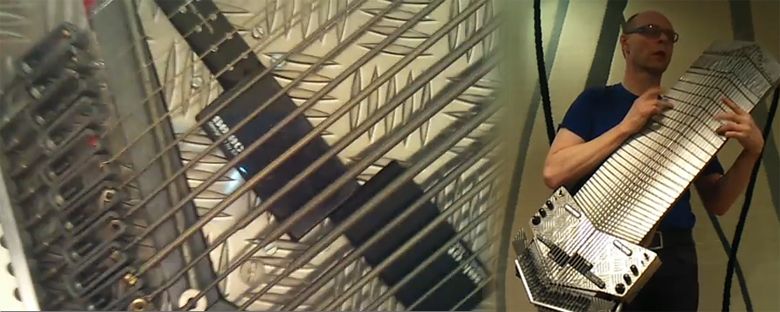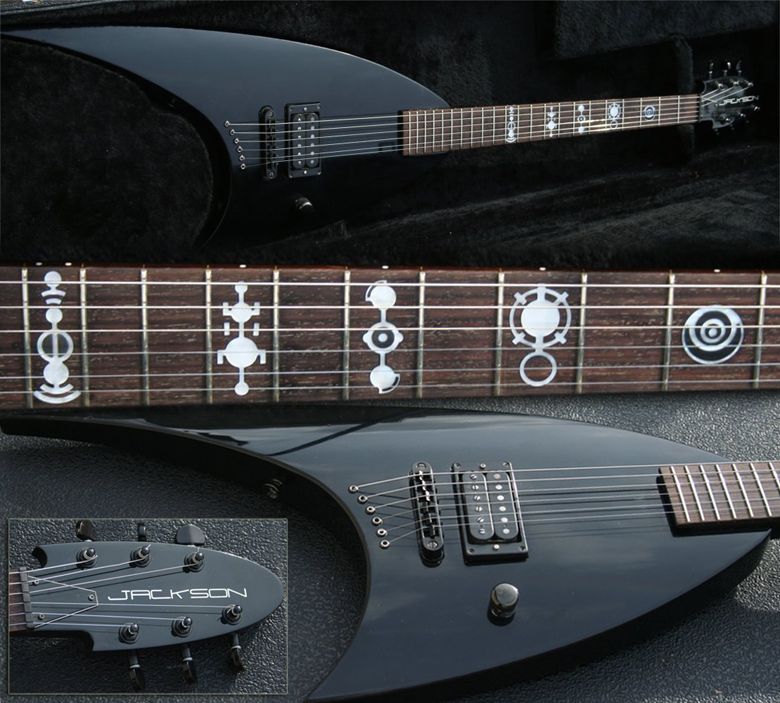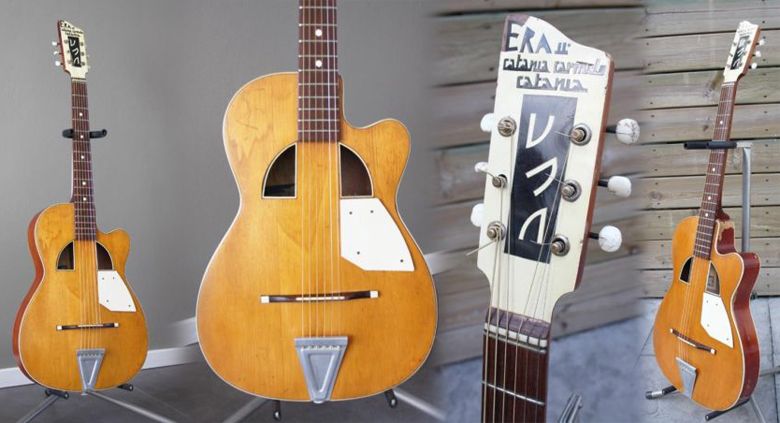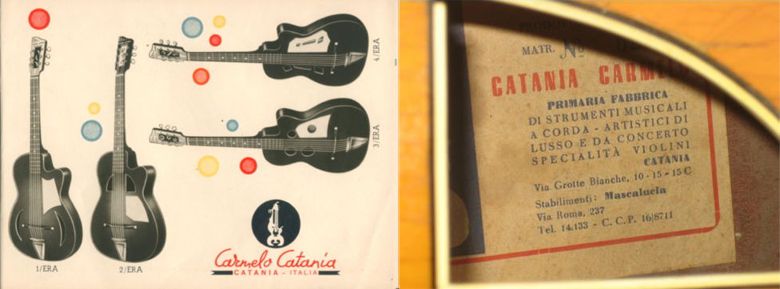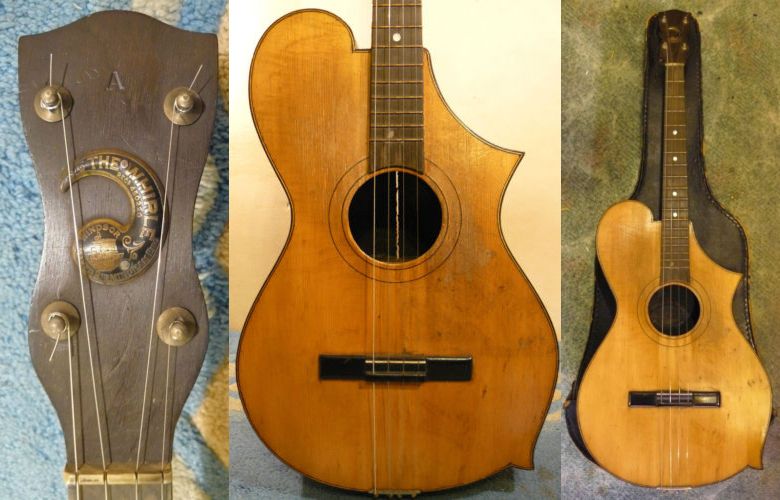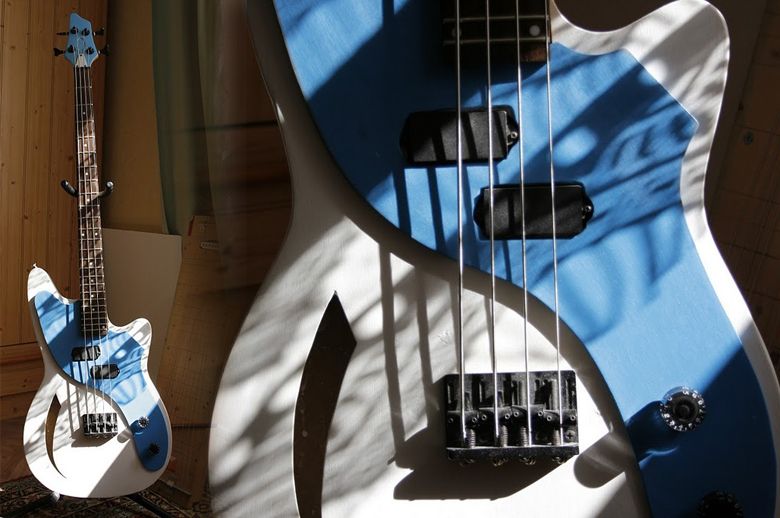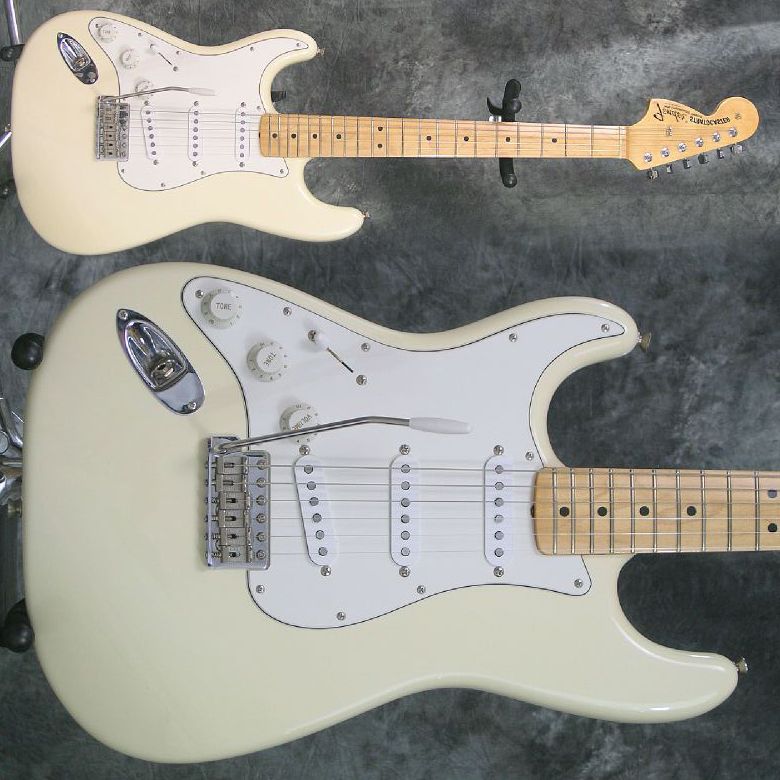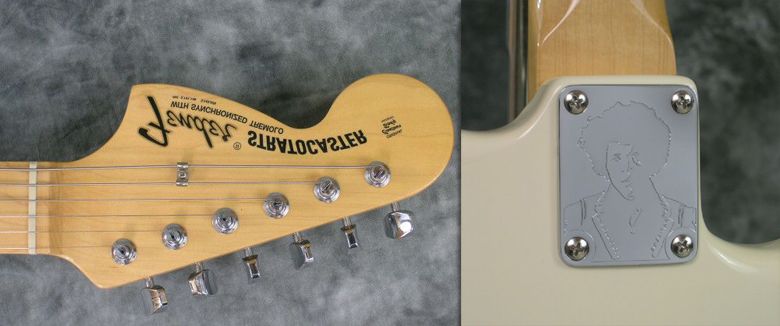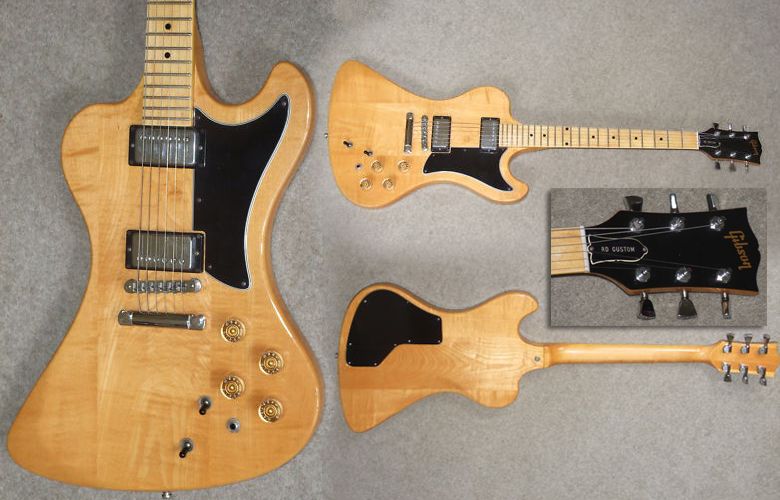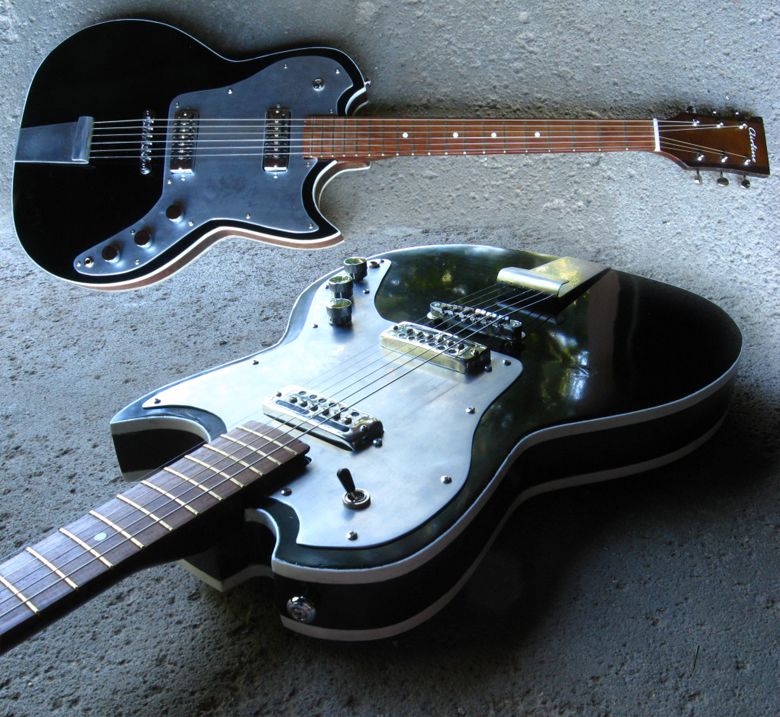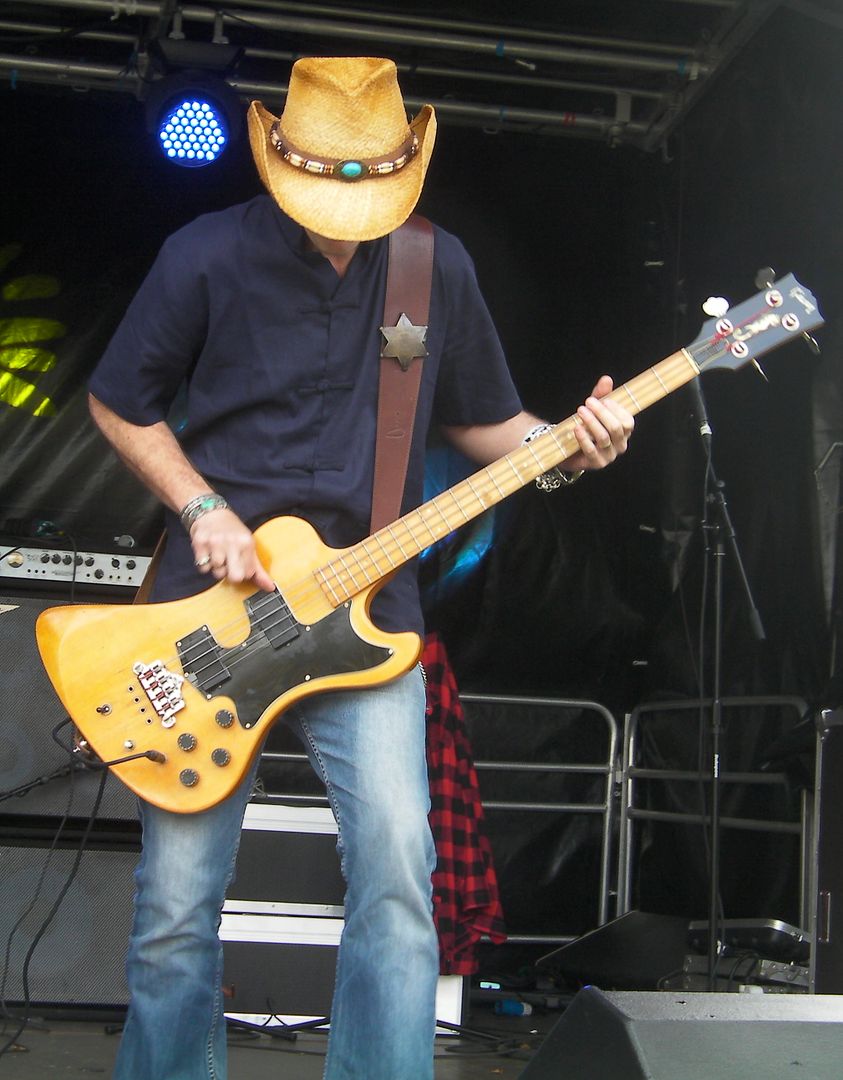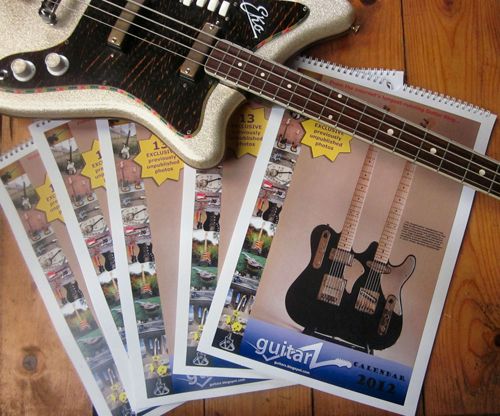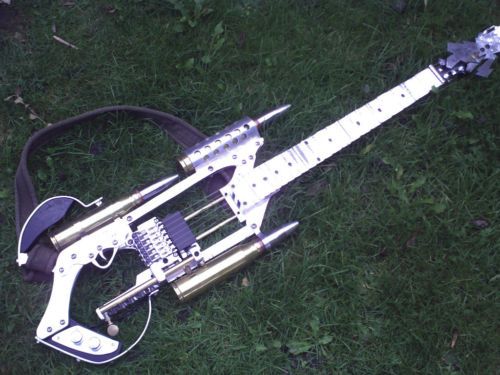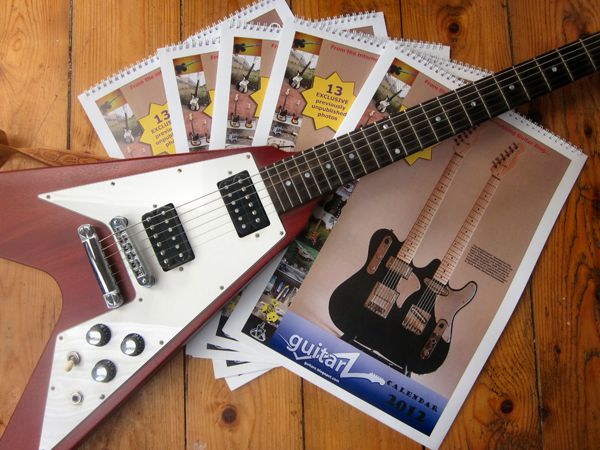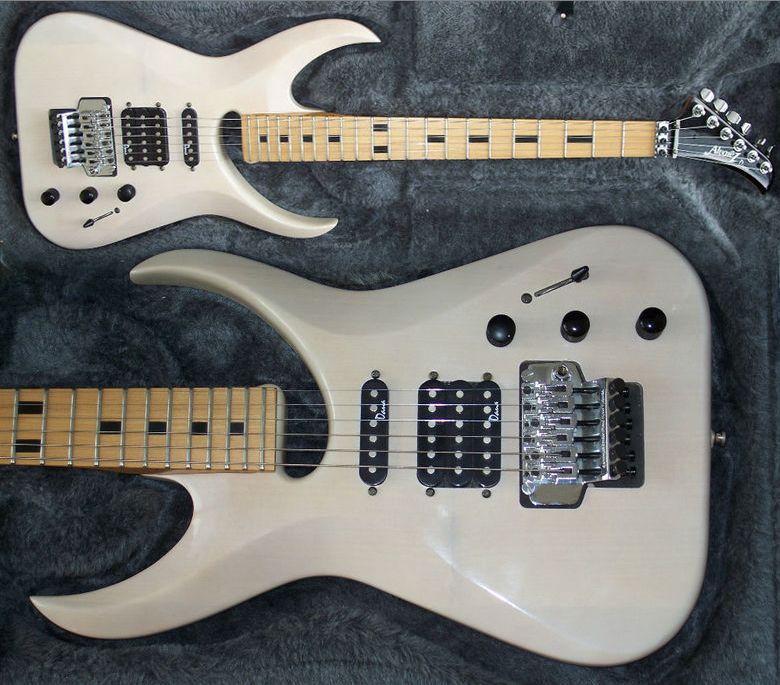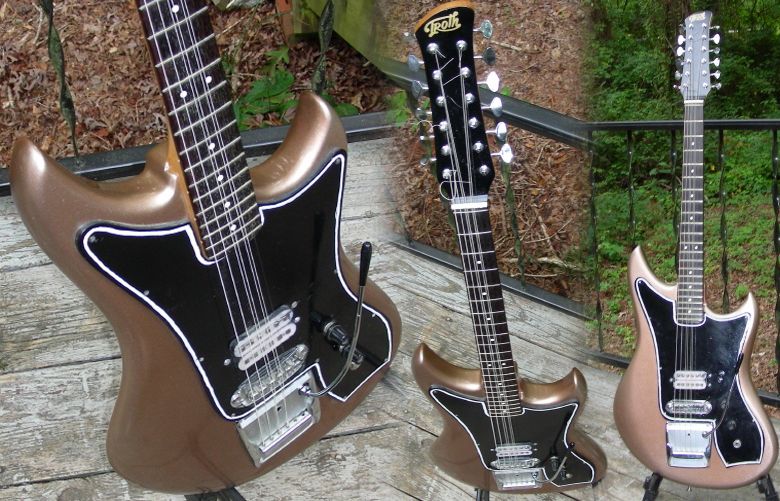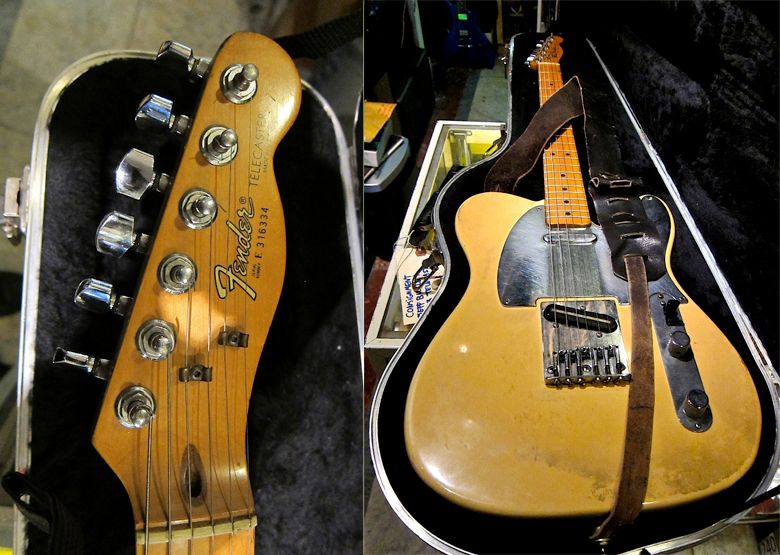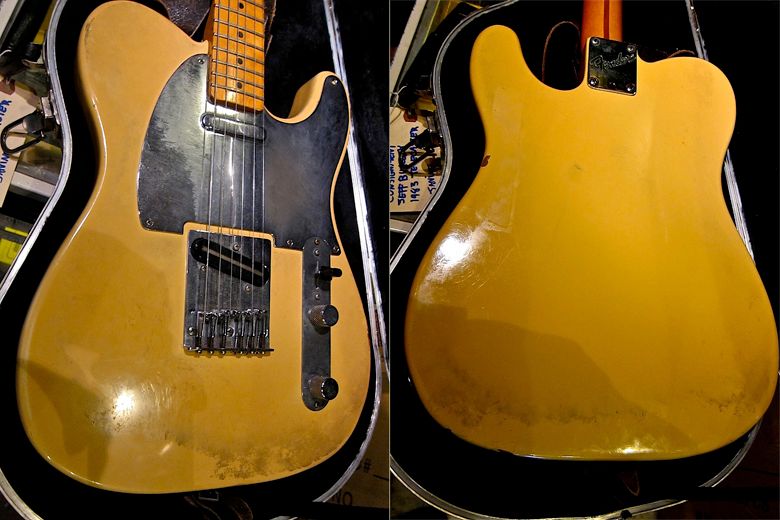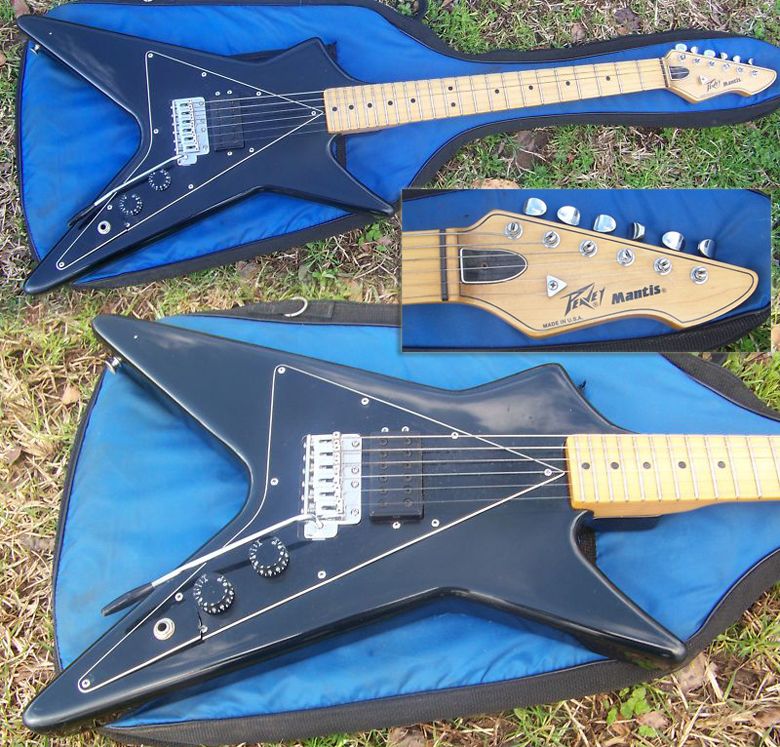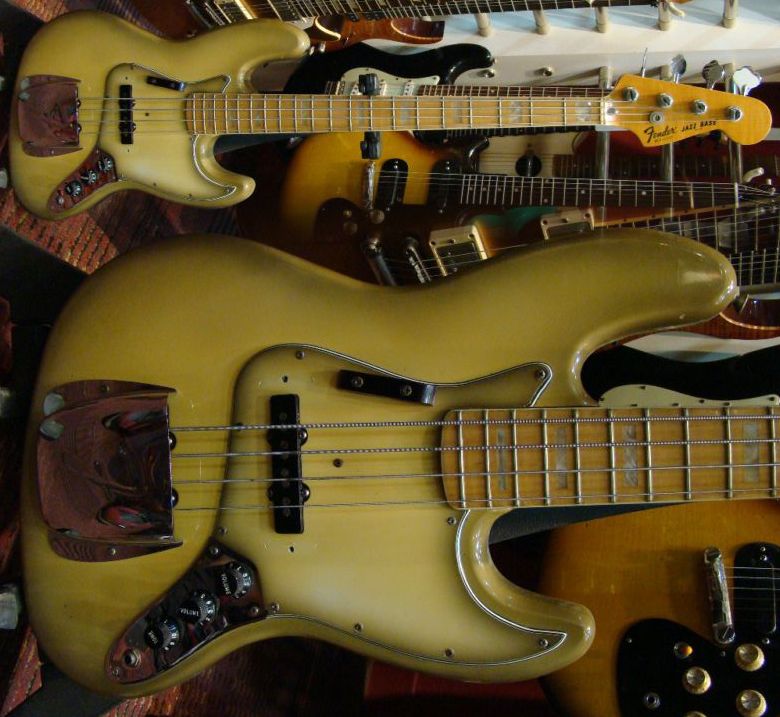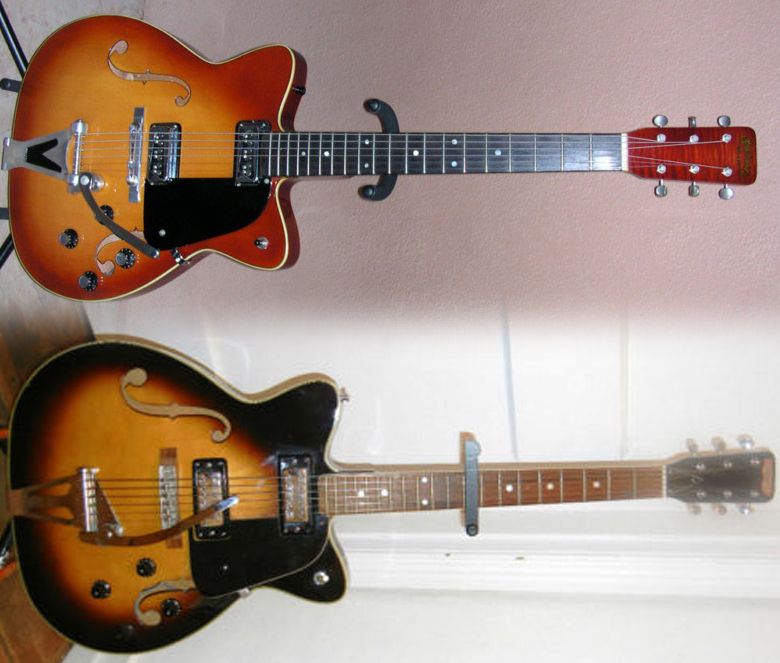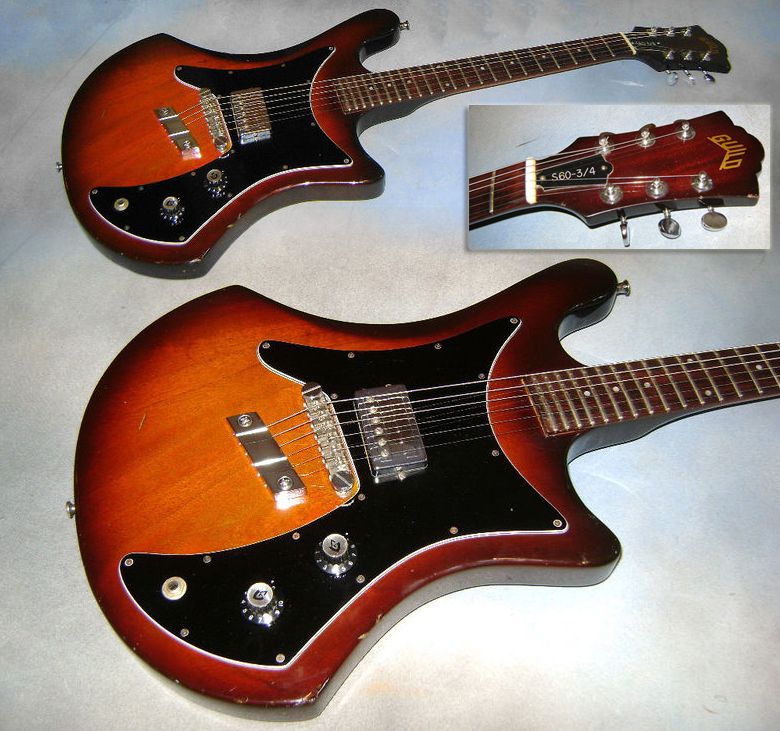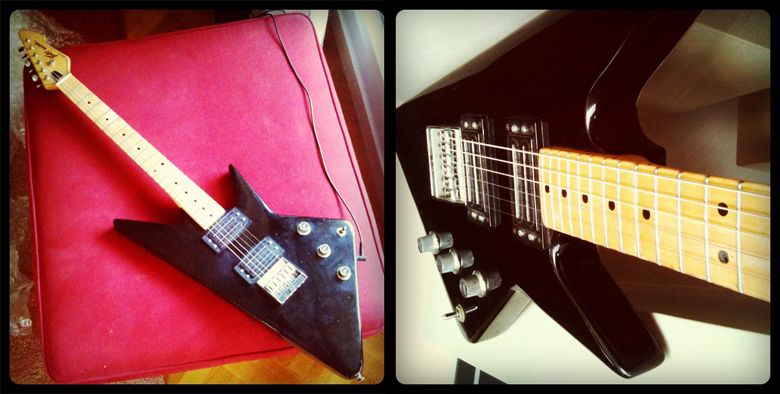guitarz.blogspot.com:
The ebay auction for this Barth guitar from 1959 ends in just a few minutes, although I suspect it may be re-listed. It currently has a Buy It Now price of $899; maybe it'll be a little less with the next listing.
If you think the design looks familiar, bear in mind that Paul Barth, besides designing for Magnatone and Mosrite, was also a designer at Rickenbacker. It does look very Rickenbacker-like, doesn't it?
G L Wilson
EDIT: Sure enough it's been re-listed, although the price remains unchanged.
© 2011, Guitarz - The Original Guitar Blog - now in its 10th year!
Friday 30 September 2011
Rare unusual Tennessee see-thru acoustic electric guitar
guitarz.blogspot.com:

I came across this wee beastie on eBay this evening and of course, it caught my eye.
This is what the seller had to say
The bow in the neck and problems closing the battery compartment are a little off-putting though and, I thought I'd better check and see if we've posted about these before and found that Gavin had in fact posted a few rather damning articles on the Tennessee brand. Like this one in April 2008.

I came across this wee beastie on eBay this evening and of course, it caught my eye.
This is what the seller had to say
RARE UNUSUAL TENNESSEE SEE THRU ACOUSTIC ELECTRIC GUITARFor $150, it seemed worth checking out. There are some interesting features, quite apart from the skeletal form. The long - to my eyes country looking - headstock, the add-on comfy chair armrest/horns bearing more than a passing resemblance to the OpenSource inspired ZoyBar and the decidedly painted on finish adding a craftsman-like retro feel to it.
I've Exhausted Myself Trying To Find Information Online About This Guitar, And Can't Seem To Find Any! It's A Very Imaginative Style & Plays & Sounds Like It Should. The Neck Has A Very Slight Bow To It, But Doesn't Affect The Playing. I Tuned It To An Open D Tuning & Played Some Bottleneck With It & Was Surprised At Well It Did. It Has A Built In Pickup That Sounds Very Good, & It Takes A 9 Volt Battery. It's A Little Tricky To Close The Battery Access Cover. You Can Be The Only Kid On The Block, Or IN TheCity, Or Maybe The State, To Have One Of These Very Cool Tennessee Guitars.
Buy It Now For $149
The bow in the neck and problems closing the battery compartment are a little off-putting though and, I thought I'd better check and see if we've posted about these before and found that Gavin had in fact posted a few rather damning articles on the Tennessee brand. Like this one in April 2008.
It's hard to see where the marketing strategy for these instruments is heading and that makes things all the more confusing. It seems they are, generally, pretty cheap (in both senses of the word) and pretty weird designs. To me, beginners are most like to go for a recognisable guitar (LP, Tele, Strat?), more experienced players for a better quality and experimentalists will be concocting their own. That only really leaves more experimentalists who would buy it on a whim just see if it could make sounds that other guitars can't or performers looking for something different on stage. This seems quite a narrow niche.
I applaud the fact that these instruments are pretty off the wall but considering the standards set by run of the mill brands (like Squier) these days, they must be a difficult sell, especially when they appear to be so shoddy.
I applaud the fact that these instruments are pretty off the wall but considering the standards set by run of the mill brands (like Squier) these days, they must be a difficult sell, especially when they appear to be so shoddy.
David in Barcelona
© 2011, Guitarz - The Original Guitar Blog - now in its 10th year!
Thursday 29 September 2011
Musima Lead Star superstrat
Usually when one thinks of GDR electric guitars, what comes to mind are superb and very German hollow-body jazz guitars, or these later through-the-looking-glass designs, both familiar and askew, sometimes radically and wildly beautiful (have you seen the sublime Marma in the Guitarz 2012 calendar? what, you don't have it yet?), sometimes rough and uninspired, but all well rooted in the Continental European guitar flourishing of the 1960s that happened mostly in Italy and Germany...
Well that's what I thought so far - until I discovered this Lead Star guitar by Musima, the perfect 1980s Japanese-style superstrat with the long pointy horns, the bridge humbucker and the fancy finish - though it doesn't have a Floyd Rose trem but a classic strat one, probably a patent issue, if not a budget one...
It's one of the latest Musima electric guitar models before the post-reunification progressive collapse of the famous company. Online information starts to be a little more solid, there is now a good page on Schlaggitarren.de - in German but the Google instant translation isn't too bad!
Bertram
© 2011, Guitarz - The Original Guitar Blog - now in its 10th year!
1981 Ibanez Blazer Bass - one of the earliest appearances of the Swirl finish, perhaps?
guitarz.blogspot.com:
Made in Japan by Hoshino Gakki Co. in 1981, this Ibanez Blazer bass is finished in red/black swirl. I'd always thought that those swirl finishes began in the 1990s with Steve Vai and his Ibanez JEM and Universe guitars, but I admit I am not an Ibanez expert.
This Blazer bass is modelled closely on the Fender Precision Bass (whilst the Blazer guitar is similarly modelled on the Stratocaster). Dare I say it, but to my eyes it looks much more attractive than a P-Bass, which I always thought looked rather "clunky". Note the (now tarnished) brass hardware which was commonplace on Japanese guitars and basses of this era. The body is Ash underneath that swirl so it ought to be good and solid, the neck is maple, and the bass is equipped with Super P-4 pickups.
The seller claims that "The neck on this bass is so sweet it puts a Fender to shame!", which could be seller's spin but I am seriously inclined to believe, especially given the period in which this was made.
Currently listed on eBay with a very reasonable Buy It Now price of $449.
G L Wilson
© 2011, Guitarz - The Original Guitar Blog - now in its 10th year!
Made in Japan by Hoshino Gakki Co. in 1981, this Ibanez Blazer bass is finished in red/black swirl. I'd always thought that those swirl finishes began in the 1990s with Steve Vai and his Ibanez JEM and Universe guitars, but I admit I am not an Ibanez expert.
This Blazer bass is modelled closely on the Fender Precision Bass (whilst the Blazer guitar is similarly modelled on the Stratocaster). Dare I say it, but to my eyes it looks much more attractive than a P-Bass, which I always thought looked rather "clunky". Note the (now tarnished) brass hardware which was commonplace on Japanese guitars and basses of this era. The body is Ash underneath that swirl so it ought to be good and solid, the neck is maple, and the bass is equipped with Super P-4 pickups.
The seller claims that "The neck on this bass is so sweet it puts a Fender to shame!", which could be seller's spin but I am seriously inclined to believe, especially given the period in which this was made.
Currently listed on eBay with a very reasonable Buy It Now price of $449.
G L Wilson
© 2011, Guitarz - The Original Guitar Blog - now in its 10th year!
Wednesday 28 September 2011
Yamaha SG-40 Japanese-made singlecut solidbody electric guitar from 1972
guitarz.blogspot.com:
Here's a Yamaha SG-40, another of their earlier solidbody guitars, this one dating from 1972. It's a relation of the Les Paul-like Yamaha SG-45 that we already looked at back in March of this year, but is has a bolt-on neck rather than a set neck, and a generous and attractive German carve to the top, with body and headstock face finished in a vibrant solid red. Together with the angled neck pickup, this guitar has something of a Mosrite vibe.
Specs include: bolt-on mahogany neck with bound rosewood fretboard, pearloid dot inlays, 22 frets, 2 humbucking pickups, adjustable terminator type hard-tail bridge, original Yamaha tear-drop tuners, 24 3/4" scale length with a nut width of 1-3/4"
Currently listd on eBay with a Buy It now price of $795.
G L Wilson
© 2011, Guitarz - The Original Guitar Blog - now in its 10th year!
Here's a Yamaha SG-40, another of their earlier solidbody guitars, this one dating from 1972. It's a relation of the Les Paul-like Yamaha SG-45 that we already looked at back in March of this year, but is has a bolt-on neck rather than a set neck, and a generous and attractive German carve to the top, with body and headstock face finished in a vibrant solid red. Together with the angled neck pickup, this guitar has something of a Mosrite vibe.
Specs include: bolt-on mahogany neck with bound rosewood fretboard, pearloid dot inlays, 22 frets, 2 humbucking pickups, adjustable terminator type hard-tail bridge, original Yamaha tear-drop tuners, 24 3/4" scale length with a nut width of 1-3/4"
Currently listd on eBay with a Buy It now price of $795.
G L Wilson
© 2011, Guitarz - The Original Guitar Blog - now in its 10th year!
Tuesday 27 September 2011
1964 Gibson ES-120 T (T is for thinline)
This Gibson ES-120 T is the cheapest ever Gibson archtop model. Produced between 1962 and 1971, it could achieve its budget price by having all its electronics mounted on its scratch plate - single-coil pickup, pots and jack output - this allowing only one F-hole.
Once a total cheapo, as a vintage Gibson guitar, it can nowadays be considered as a collector, but who cares?
Bertram
© 2011, Guitarz - The Original Guitar Blog - now in its 10th year!
What's that weird guitar on page 15 of the book "500 Guitars"?
guitarz.blogspot.com:
Via the Amazon.com page for "500 Guitars", Thomas Kelly has asked the following question:
STOP PRESS... Antoine L tells us that:
© 2011, Guitarz - The Original Guitar Blog - now in its 10th year!
Via the Amazon.com page for "500 Guitars", Thomas Kelly has asked the following question:
What is the guitar on page 15? According to the book it should be the 57 Chevy but I can't find this model anywhere on the internet.My answer (which a friend has posted on Amazon.com for me because having a UK Amazon account I am unable to post on the American site) is as follows:
Hi Thomas,G L Wilson
I wish the publishers had let me check through the proofs before going to print because they got a lot of the pictures wrong. I did offer to do this for them and was never taken up on the offer. Right at the start I was told I could choose ANY guitars I wanted to write about and that their art department would find the pictures, and that it wouldn't be a problem.
The guitar in the picture on page 15 is a guitar made by Auerswald Instruments, a German company specialising in innovative designs. On page 22 there is a write up of the Auerswald Model C guitar, but the picture on page 15 isn't a Model C. It's not a model currently on their website but you'll see from the other guitars in the range that stylistically it shares many traits including the "Sustain Bow" arm connecting the head to the body.
If you want to see a picture of a 57 Chevy, just Google "American Showster 57 Chevy" and check the images!
STOP PRESS... Antoine L tells us that:
"It is not a Auerswald. It's a model inspired by Auerswald made by Ed Roman:Grrrrr... This is what happens when you let your publishers collect together the photos to go in your guitar book.
http://www.edroman.com/guitars/abstract/kingpin.htm
© 2011, Guitarz - The Original Guitar Blog - now in its 10th year!
Monday 26 September 2011
Can anyone help identify this weird stringed instrument?
guitarz.blogspot.com:
© 2011, Guitarz - The Original Guitar Blog - now in its 10th year!
Hey Guitarz guys, this is James from Krazy Kat Music. We need your help identifying one of the weirdest instruments we've ever seen. It's like a lap steel, but has really weird bars that rotate and fret the strings when you push a button near the headstock. So bizarre!
So funky.
James
krazy kat
© 2011, Guitarz - The Original Guitar Blog - now in its 10th year!
Yamaha SG-3 guest blog article over at Vintage & Rare
guitarz.blogspot.com:
I've written a guest blog article for our friends at Vintage & Rare. It's all about what regular readers will recognize as a favourite hobby horse of mine, the Yamaha SG-3 guitar.
You can read all about it (plus siblings, the SG-2, SG-12 and SB-2) here.
G L Wilson
© 2011, Guitarz - The Original Guitar Blog - now in its 10th year!
I've written a guest blog article for our friends at Vintage & Rare. It's all about what regular readers will recognize as a favourite hobby horse of mine, the Yamaha SG-3 guitar.
You can read all about it (plus siblings, the SG-2, SG-12 and SB-2) here.
G L Wilson
© 2011, Guitarz - The Original Guitar Blog - now in its 10th year!
Sunday 25 September 2011
One-off homemade 59 Cadillac tail-fin guitar
guitarz.blogspot.com:
Probably inspired by the American Showster Cadillac guitar, this home-built guitar uses Strat-style parts (neck, pickups, electrics) mounted on an almost V-like body which is supposedly reminiscent of the tail-fin of a particular classic American automobile. To add verisimilitude, it is outfitted with a working tail-light.
It is currently listed on eBay UK with a starting price of £10.
G L Wilson
© 2011, Guitarz - The Original Guitar Blog - now in its 10th year!
Probably inspired by the American Showster Cadillac guitar, this home-built guitar uses Strat-style parts (neck, pickups, electrics) mounted on an almost V-like body which is supposedly reminiscent of the tail-fin of a particular classic American automobile. To add verisimilitude, it is outfitted with a working tail-light.
It is currently listed on eBay UK with a starting price of £10.
G L Wilson
© 2011, Guitarz - The Original Guitar Blog - now in its 10th year!
Steinberger GM1T Egyptian - one-off NAMM 1991 special
guitarz.blogspot.com:
I've always enjoyed 1960s Italian Ekos and Crucianellis with their ostentatious celluloid pearlescent finishes; likewise similarly finished models from Sweden's Hagström have also appealed. But looking at the above Steinberger GM1T Egyptian, I have to ask myself if it's possible to put too much Mother Of Toilet Seat onto a guitar?
The Ancient Egyptian-themed finish on this Steinberger was created for the 1991 NAMM show by artists Greg Rich and Phil Jones, who apparently have created similar pieces for Fender and Gibson. The guitar has just the single EMG pickup - I guess so there is more of a "canvass" available for the artwork - and it also sports a gold-plated TransTrem (a Steinberger innovation which allows the player to lock in transposed tunings using the tremolo arm).
Apparently this guitar sold at the 1991 NAMM show for $10,000. It is now being offered for sale on eBay with a Buy It Now price of $5,995.
G L Wilson
© 2011, Guitarz - The Original Guitar Blog - now in its 10th year!
I've always enjoyed 1960s Italian Ekos and Crucianellis with their ostentatious celluloid pearlescent finishes; likewise similarly finished models from Sweden's Hagström have also appealed. But looking at the above Steinberger GM1T Egyptian, I have to ask myself if it's possible to put too much Mother Of Toilet Seat onto a guitar?
The Ancient Egyptian-themed finish on this Steinberger was created for the 1991 NAMM show by artists Greg Rich and Phil Jones, who apparently have created similar pieces for Fender and Gibson. The guitar has just the single EMG pickup - I guess so there is more of a "canvass" available for the artwork - and it also sports a gold-plated TransTrem (a Steinberger innovation which allows the player to lock in transposed tunings using the tremolo arm).
Apparently this guitar sold at the 1991 NAMM show for $10,000. It is now being offered for sale on eBay with a Buy It Now price of $5,995.
G L Wilson
© 2011, Guitarz - The Original Guitar Blog - now in its 10th year!
Saturday 24 September 2011
Two very different Ovation Breadwinners currently listed on eBay
guitarz.blogspot.com:
These two different Ovation Breadwinners currently listed on eBay illustrate quite nicely how the instrument had evolved over the eight years or so during which it was part of the Ovation catalogue of instruments. One of Ovation's earliest solidbody electric guitars, the Breadwinner, introduced in 1972, is known for its serendipitous ergonomic shape and for being one of the earliest production guitars to be equipped with an onboard active FET preamp.
The white Breadwinner at the top of the picture is quite an early example, although not one of the earliest. The first Breadwinners had the output jack on the side of the guitar just inside the rear cutaway, which was a bad move because that rear cutaway is the perfect place to rest the guitar against your right leg when playing seated. Ovation very wisely relocated the socket to the front of the guitar, which is where you'll find it on most models. Other features of this example are the textured "LyraChord" finish (colours available included blue, white, black, tan, grey, and red), the nylon bridge saddles, and the large toroidal single pole pickups.
The Breadwinner Limited seen at the bottom of the picture dates from 1980 when production of the Breadwinner had effectively stopped. The Breadwinner Limited model was an exercise in using up old stock. In a move similar to Fender CBS remodelling the bodies of Fender XIIs and five-string basses to produce new models, the Maverick and the Swinger, Ovation re-sculpted Breadwinner bodies with a cut-away on the top edge to give the guitar a much sleeker look. Finishes were usually natural (which had previously only been the domain of the Ovation Deacon - the deluxe version of the Breadwinner), although some examples were available in a "Tuxedo" grey to black finish. The pickguard is also much smaller, and pickups are Ovation's own mini-humbucking units. The bridge saddles are of brass which probably is more durable and allows for better sustain than nylon. Apparently approximately 500 examples of the Ovation Breadwinner Limited were produced.
(Incidentally, my own Ovation Breadwinner is right inbetween these two styles. It has the original shape but with a glossy black finish in place of the more usual LyraChord textured finish. The bridge has brass saddles and the pickups are mini humbuckers mounted on the smaller version of the pickguard.)
The white Breadwinner is currently listed on eBay with a Buy It Now price of $875
The Breadwinner Limited is currently listed on eBay with a Buy It Now price of $1,799. This listing is due to finish later today, although I suspect that it won't sell and will probably be re-listed. Even though the Limiteds were rarer, I feel that the price for the white Breadwinner is probably the more realistic of the two.
G L Wilson
© 2011, Guitarz - The Original Guitar Blog - now in its 10th year!
These two different Ovation Breadwinners currently listed on eBay illustrate quite nicely how the instrument had evolved over the eight years or so during which it was part of the Ovation catalogue of instruments. One of Ovation's earliest solidbody electric guitars, the Breadwinner, introduced in 1972, is known for its serendipitous ergonomic shape and for being one of the earliest production guitars to be equipped with an onboard active FET preamp.
The white Breadwinner at the top of the picture is quite an early example, although not one of the earliest. The first Breadwinners had the output jack on the side of the guitar just inside the rear cutaway, which was a bad move because that rear cutaway is the perfect place to rest the guitar against your right leg when playing seated. Ovation very wisely relocated the socket to the front of the guitar, which is where you'll find it on most models. Other features of this example are the textured "LyraChord" finish (colours available included blue, white, black, tan, grey, and red), the nylon bridge saddles, and the large toroidal single pole pickups.
The Breadwinner Limited seen at the bottom of the picture dates from 1980 when production of the Breadwinner had effectively stopped. The Breadwinner Limited model was an exercise in using up old stock. In a move similar to Fender CBS remodelling the bodies of Fender XIIs and five-string basses to produce new models, the Maverick and the Swinger, Ovation re-sculpted Breadwinner bodies with a cut-away on the top edge to give the guitar a much sleeker look. Finishes were usually natural (which had previously only been the domain of the Ovation Deacon - the deluxe version of the Breadwinner), although some examples were available in a "Tuxedo" grey to black finish. The pickguard is also much smaller, and pickups are Ovation's own mini-humbucking units. The bridge saddles are of brass which probably is more durable and allows for better sustain than nylon. Apparently approximately 500 examples of the Ovation Breadwinner Limited were produced.
(Incidentally, my own Ovation Breadwinner is right inbetween these two styles. It has the original shape but with a glossy black finish in place of the more usual LyraChord textured finish. The bridge has brass saddles and the pickups are mini humbuckers mounted on the smaller version of the pickguard.)
The white Breadwinner is currently listed on eBay with a Buy It Now price of $875
The Breadwinner Limited is currently listed on eBay with a Buy It Now price of $1,799. This listing is due to finish later today, although I suspect that it won't sell and will probably be re-listed. Even though the Limiteds were rarer, I feel that the price for the white Breadwinner is probably the more realistic of the two.
G L Wilson
© 2011, Guitarz - The Original Guitar Blog - now in its 10th year!
Friday 23 September 2011
1977 Gibson RD Artist Bass (again)
guitarz.blogspot.com:
This is a postscript to our blog post last week where we were asked to identify a Gibson bass which turned out to be a Gibson RD Artist Bass.
The example pictured here is currently being offered for sale on eBay UK, with a Buy It Now price of £2,150, which to me sounds a tad optimistic but I'll be watching to see if it sells.
G L Wilson
© 2011, Guitarz - The Original Guitar Blog - now in its 10th year!
This is a postscript to our blog post last week where we were asked to identify a Gibson bass which turned out to be a Gibson RD Artist Bass.
The example pictured here is currently being offered for sale on eBay UK, with a Buy It Now price of £2,150, which to me sounds a tad optimistic but I'll be watching to see if it sells.
G L Wilson
© 2011, Guitarz - The Original Guitar Blog - now in its 10th year!
Martin 5-16 Terz Guitar - vintage short-scale acoustic from 1962
guitarz.blogspot.com:
On first sighting I thought that this diminutive Martin 5-16 from 1962 was a parlour guitar, but apparently it is a Terz guitar. Seeing as the seller refers to the "low E" string and the strings pictured on the guitar are obviously a heavy set, I suspect that this example doesn't use the correct Terz guitar tuning.
The Terz guitar, popular in the 19th Century, is a short scale guitar pitched at a minor third higher than a regular guitar, giving it a clear tone that carries well. Originally, Terz guitars were unlikely to have been used as solo instruments, rather they were a component in ensembles and guitar duos, etc. The Italian composer Mauro Giuliani, guitar virtuoso of the early 1900s, composed extensively for the Terz guitar as a compliment to the prime guitar.
This Martin 5-16 is in stunning "time capsule" condition for an instrument nearly 50 years old and is currently listed on eBay with a Buy It Now price of $2,750.
G L Wilson
© 2011, Guitarz - The Original Guitar Blog - now in its 10th year!
On first sighting I thought that this diminutive Martin 5-16 from 1962 was a parlour guitar, but apparently it is a Terz guitar. Seeing as the seller refers to the "low E" string and the strings pictured on the guitar are obviously a heavy set, I suspect that this example doesn't use the correct Terz guitar tuning.
The Terz guitar, popular in the 19th Century, is a short scale guitar pitched at a minor third higher than a regular guitar, giving it a clear tone that carries well. Originally, Terz guitars were unlikely to have been used as solo instruments, rather they were a component in ensembles and guitar duos, etc. The Italian composer Mauro Giuliani, guitar virtuoso of the early 1900s, composed extensively for the Terz guitar as a compliment to the prime guitar.
This Martin 5-16 is in stunning "time capsule" condition for an instrument nearly 50 years old and is currently listed on eBay with a Buy It Now price of $2,750.
G L Wilson
© 2011, Guitarz - The Original Guitar Blog - now in its 10th year!
Thursday 22 September 2011
Dude taps away on 24 strings on his homemade monster metal bass
guitarz.blogspot.com:
Cor blimey, guvnor! When I first saw the picture of this thing I thought it might be a Star Trek fan posing with some exotic piece of Klingon weaponry. But no, apparently it's a touch-style 24-string "bass" (not sure why it can't be called a "guitar", but that's what the fellow calls it).
I know, I've been very cynical in the past about such multi-stringed instruments and "extended range basses", and even have my own catchphrase to be used in the eventuality of sighting such a beastie: "Is that enough strings? Just buy a harp already!"
But I've been told that I shouldn't be so closed-minded, so I'll let you watch this chappie in action on his 24-string bass in the below video and allow you make up your own minds.
Actually, someone commented on YouTube, "Whats the point in having that many strings?", and 24-string bass chappie answered, "There is no 'point', I just love to play stringed instruments!" which, I guess, is fair enough. It's like the answer to the old question "Why climb that mountain?" with "Because it's there!" In this instance, it's "Why have so many strings? Because I can!"
Love it or loathe it, it doesn't matter. It's worthy of a blog post on Guitarz for weirdness factor alone.
G L Wilson
© 2011, Guitarz - The Original Guitar Blog - now in its 10th year!
Cor blimey, guvnor! When I first saw the picture of this thing I thought it might be a Star Trek fan posing with some exotic piece of Klingon weaponry. But no, apparently it's a touch-style 24-string "bass" (not sure why it can't be called a "guitar", but that's what the fellow calls it).
I know, I've been very cynical in the past about such multi-stringed instruments and "extended range basses", and even have my own catchphrase to be used in the eventuality of sighting such a beastie: "Is that enough strings? Just buy a harp already!"
But I've been told that I shouldn't be so closed-minded, so I'll let you watch this chappie in action on his 24-string bass in the below video and allow you make up your own minds.
Actually, someone commented on YouTube, "Whats the point in having that many strings?", and 24-string bass chappie answered, "There is no 'point', I just love to play stringed instruments!" which, I guess, is fair enough. It's like the answer to the old question "Why climb that mountain?" with "Because it's there!" In this instance, it's "Why have so many strings? Because I can!"
Love it or loathe it, it doesn't matter. It's worthy of a blog post on Guitarz for weirdness factor alone.
G L Wilson
© 2011, Guitarz - The Original Guitar Blog - now in its 10th year!
Joe Till Guitars TG-250 "Lady on the Beach" #145
guitarz.blogspot.com:
I was browsing the guitars on eBay and this handmade in the USA guitar by luthier Joe Till caught my attention. Till is based in California and builds each guitar by hand, sometimes using reclaimed timbers from doors, floors or furniture. This particular guitar, Joe Till Guitars model TG-250, #145, is named "Lady on the Beach" and is finished in quite an eyecatching "swampburst". The shape is akin to a Fender Jazzmaster, although the Lady on the Beach is a much more luxurious affair with a set neck and a highly sculpted semi-hollow body based around a core of alder and with a curly maple top and back. Pickups are a pair of Seymour Duncans (SH-2 "Jazz" at the neck, SH-4 "JB" at the bridge) which are fuily tapped for the full range of tones.
You know that with an exquisitely hand-built guitar such as this it's not going to come cheap. This example has been "manufacturer refurbished" after having been played by customers in a guitar store and gaining the odd minor abrasion; it is currently listed on eBay with a starting price of $2,150.
G L Wilson
© 2011, Guitarz - The Original Guitar Blog - now in its 10th year!
I was browsing the guitars on eBay and this handmade in the USA guitar by luthier Joe Till caught my attention. Till is based in California and builds each guitar by hand, sometimes using reclaimed timbers from doors, floors or furniture. This particular guitar, Joe Till Guitars model TG-250, #145, is named "Lady on the Beach" and is finished in quite an eyecatching "swampburst". The shape is akin to a Fender Jazzmaster, although the Lady on the Beach is a much more luxurious affair with a set neck and a highly sculpted semi-hollow body based around a core of alder and with a curly maple top and back. Pickups are a pair of Seymour Duncans (SH-2 "Jazz" at the neck, SH-4 "JB" at the bridge) which are fuily tapped for the full range of tones.
You know that with an exquisitely hand-built guitar such as this it's not going to come cheap. This example has been "manufacturer refurbished" after having been played by customers in a guitar store and gaining the odd minor abrasion; it is currently listed on eBay with a starting price of $2,150.
G L Wilson
© 2011, Guitarz - The Original Guitar Blog - now in its 10th year!
Wednesday 21 September 2011
Azumi Nanyo subtly pointy guitar
Azumi is a very obscure Japanese guitar company, once I've written that they were (most likely) made in the Chushin Gakki factory, I've exhausted all I know about it... But looking at the sober design of this Azumi Nanyo, the neck-through-body construction and the active dual blades humbuckers, I would say it's one of these pre-metal no-nonsense guitars from the 1980s and probably a good guitar.
I love its pointy symmetrical double cutaway, better than both the Gibson and Yamaha SGs, and its transparent black finish. When everybody is all about either super classic vintage guitars or bizarre ones, I have a soft spot for these MIJ almost vintage models - and this is one of the best I've ever seen...
Bertram
© 2011, Guitarz - The Original Guitar Blog - now in its 10th year!
Tuesday 20 September 2011
Jackson Roswell Rhodes UFO-themed guitar with cool "crop circle" inlays
guitarz.blogspot.com:
I'm not normally a fan of pointy guitars intended for metal music, and although I realise that the shape of this Jackson Roswell Rhodes is most impractical, I do enjoy the simplicity of its design which manages to convey the intended UFO imagery perfectly. I particularly like the fingerboard inlays which appear to be characters from some weird alien script, or alternatively crop circle designs (even though the sensible among us know that all crop circles are created by hoaxers and/or artists). I can't imagine using it for a studio instrument or around the house or for playing when seated but I'm sure it would make a fantastic stage guitar for the right band.
Currently listed on ebay UK with a starting price of £369.
G L Wilson
© 2011, Guitarz - The Original Guitar Blog - now in its 10th year!
I'm not normally a fan of pointy guitars intended for metal music, and although I realise that the shape of this Jackson Roswell Rhodes is most impractical, I do enjoy the simplicity of its design which manages to convey the intended UFO imagery perfectly. I particularly like the fingerboard inlays which appear to be characters from some weird alien script, or alternatively crop circle designs (even though the sensible among us know that all crop circles are created by hoaxers and/or artists). I can't imagine using it for a studio instrument or around the house or for playing when seated but I'm sure it would make a fantastic stage guitar for the right band.
Currently listed on ebay UK with a starting price of £369.
G L Wilson
© 2011, Guitarz - The Original Guitar Blog - now in its 10th year!
Carmelo Catania Era II vintage jazz guitar from Sicily
guitarz.blogspot.com:
For me there is nothing worse design-wise on an acoustic guitar than weird soundholes that just don't work aesthetically. A number of modern guitars have soundholes of different shapes placed in various different positions - no doubt for tonal properties rather than for aesthetics - but often I just think how dreadful they look.
I do however, quite like this design on this 1950s Carmelo Catania Era II. It seems so weird to see an archtop jazz guitar with anything but f-holes, but look at the photo from Carmelo Catania's catalogue (below) and you'll see that their basic jazz guitar was offered in four versions each with different soundhole designs.
The eBay seller tells us this about Carmelo Catania:
G L Wilson
© 2011, Guitarz - The Original Guitar Blog - now in its 10th year!
For me there is nothing worse design-wise on an acoustic guitar than weird soundholes that just don't work aesthetically. A number of modern guitars have soundholes of different shapes placed in various different positions - no doubt for tonal properties rather than for aesthetics - but often I just think how dreadful they look.
I do however, quite like this design on this 1950s Carmelo Catania Era II. It seems so weird to see an archtop jazz guitar with anything but f-holes, but look at the photo from Carmelo Catania's catalogue (below) and you'll see that their basic jazz guitar was offered in four versions each with different soundhole designs.
The eBay seller tells us this about Carmelo Catania:
Throughout the 900 Sicily was one of the most relevant production centres of musical instrument together with The Marches and Lombardy. Set so far away from the high standards of the arch instruments made in Cremona and from the quality of the Neapolitan mandolins, Sicily was quickly renown as the land of luthiers. Curiously, all Sicilian luthiers were born in Catania, at the feet of Etna, the volcano.Currently listed on eBay UK with a starting price of £350 and Buy It Now price of $675.
The poor economy of the region highly contributed to the huge migrant wave in the 20s towards France that gave birth to an extraordinary school of French luthiery. The luthiers from Catania are to be mentioned: Pappalardo, Di Mauro, Amico, Anastasio, Busato, Bucolo, Castelluccia, Favino, Olivieri, Burgassi, Martella, Grizzo, Rossito, Petillo...among many others.
Luthiers in Sicily were always open to both the Baroque influence from Spain and to the innovations coming from Europe and The States. The first great star among Sicilian luthiers was surely Carmelo Catania who was the only one to understand that the image of the luthier had to become more of a businessman to survive on the internal and international market. Carmelo Catania’s golden age was from the end of the war to the 60s. The cultural and economic situation brought Carmelo Catania to produce an incredible wide range of crafted instruments on industrial scale. The few pages of his catalogue here reported show his skills in bringing together all the different external influences in a typically Sicilian sensitivity. Carmelo Catania was probably the first luthier to organize himself industrially, promoting himself, exporting guitars, settling commercial alleys and trades. He created a real production headquarter in Sicily making instruments or parts on behalf of third parties.
G L Wilson
© 2011, Guitarz - The Original Guitar Blog - now in its 10th year!
Monday 19 September 2011
British-made Windsor Whirle tenor guitar - or is it a baritone ukulele?
guitarz.blogspot.com:
This Windsor Whirle was made in Birmingham, UK, according to the eBay seller in the 1920s. Myself, I'm not so sure about that, and would widen the timeframe to anytime in the 20th Century up until the 1940s. But perhaps the seller knows something that I do not.
The guitar (or whatever it is) is not in the best of condition having developed a split in the back right down the centre. However, I feel it is worth showing here because it's such an unusual-looking instrument.
Although the seller refers to it as a "tenor guitar", I wonder if it was actually intended as a baritone ukulele. Note the gut or nylon strings rather than a tenor's usual steel strings (you can see also that the bridge was never intended for steel strings) plus the relative compactness of the whole design. The scale length is said to be 52cm - that's nearly 20 1/2" - which is nearer to baritone ukulele scale than tenor guitar (usually about 23").
A Google search for "Windsor Whirle" will tell you that they produced a range of banjos in that name. Note also the banjo-like headstock on the instrument pictured here.
(For some reason I get a sense of deja vu about this whole blog post. I could swear I've posted something similar before but cannot find it in the archives).
G L Wilson
© 2011, Guitarz - The Original Guitar Blog - now in its 10th year!
This Windsor Whirle was made in Birmingham, UK, according to the eBay seller in the 1920s. Myself, I'm not so sure about that, and would widen the timeframe to anytime in the 20th Century up until the 1940s. But perhaps the seller knows something that I do not.
The guitar (or whatever it is) is not in the best of condition having developed a split in the back right down the centre. However, I feel it is worth showing here because it's such an unusual-looking instrument.
Although the seller refers to it as a "tenor guitar", I wonder if it was actually intended as a baritone ukulele. Note the gut or nylon strings rather than a tenor's usual steel strings (you can see also that the bridge was never intended for steel strings) plus the relative compactness of the whole design. The scale length is said to be 52cm - that's nearly 20 1/2" - which is nearer to baritone ukulele scale than tenor guitar (usually about 23").
A Google search for "Windsor Whirle" will tell you that they produced a range of banjos in that name. Note also the banjo-like headstock on the instrument pictured here.
(For some reason I get a sense of deja vu about this whole blog post. I could swear I've posted something similar before but cannot find it in the archives).
G L Wilson
© 2011, Guitarz - The Original Guitar Blog - now in its 10th year!
François shows us his self-built "Frankenstein" bass
guitarz.blogspot.com:
François writes:
Below we see a montage of pictures showing the "genesis" of François's bass: its acoustic guitar and Stagg bass donors plus its early "hornless" incarnation.
Please keep those stories and photos of your own guitars and basses coming in, folks!
G L Wilson
© 2011, Guitarz - The Original Guitar Blog - now in its 10th year!
François writes:
Hello,Thank you for allowing us to see these pictures, François. It looks to be a very interesting project and the ultimate design is indeed quite pleasing to the eye (obviously I cannot comment on the sound or playability).
Firstly, excuse my English, I'm a regular reader from Nantes, France.
My bass has been in constant amelioration for the last 2 years, but I'm really satisfied with its current state, so I thougt I might send some pictures for your blog, you might be interested!
The body is originally made from a cheap 30€ short-scale accoustic guitar, that has been cut in half to achieve a semi-accoustic bass thickness. It was consolidated with pieces of wood inside, and we just had to add a new back!
The neck, pickup and hardware come from a rather ugly Stagg bass I already had.
The upper horn was added one year later, after we decided that the shape and the balance of the instrument would be greatly improved by it. It's made mostly of MDF, and foam!
I took the inspiration for the colour scheme from a Harmony acoustic guitar I saw on the Internet, maybe on your very blog, with a blue pickguard matching the headstock.
After some trouble setting the action, and a few shims added to the neck, it now sounds quite good, with a nice resonant sound coming from the hollow body, reminding me of some Danelectro basses!
My brother and I are quite proud of this build, and me of him who did most of the building work!
Regards,
François.
Below we see a montage of pictures showing the "genesis" of François's bass: its acoustic guitar and Stagg bass donors plus its early "hornless" incarnation.
Please keep those stories and photos of your own guitars and basses coming in, folks!
G L Wilson
© 2011, Guitarz - The Original Guitar Blog - now in its 10th year!
Sunday 18 September 2011
1997 Fender Stratocaster "Reverse" Jimi Hendrix tribute model
guitarz.blogspot.com:
Today is the 41st Anniversary of the death of Jimi Hendrix (18 September 1970). He was known to be quite self-effacing, so what he would have made of this Fender Hendrix Tribute Stratocaster from 1997, I don't know, but I suspect he may have been amused by it.
It's a left-handed Strat that is intended for right-handed players with an additional strap button on what would have been on the lower horn (from a leftie's perspective), and side dots on the right-handed player's side of the neck. The irony is that were a left-handed player to buy one, they'd need to invest a little time into setting it up for a left-handed player, and the lack of side dots where they'd expect them would be irritating.
Of course, it was created so that you can look a little like Hendrix in the mirror. It even has a reverse Fender Stratocaster logo on the headstock to complete the image. This must surely be the ultimate bedroom guitar.
The fact that it is a Hendrix tribute guitar is evidenced by the neck plate which bears Hendrix's image.
Of course, if you wanted a true "reverse" Strat you'd need left-handed control knobs that operate in the other direction, complete with reversed numbers and "volume" and "tone" text. You'd also need to go further and have left-handed threaded screws, and maybe even reverse wound strings... It all could get very silly.
Having said all that, and despite the fact that we at Guitarz are keen to promote guitars other than the same old usual suspects made by the biggest companies, this is a guitar that I secretly (not so secretly now, I guess) would love to own - as if I need another Strat!
This guitar is currently being offered for sale on ebay with a Buy It Now price of $2,495. It may be in excellent condition, but I feel that price is way too high. I've seen these for sale before for about a quarter of that.
G L Wilson
© 2011, Guitarz - The Original Guitar Blog - now in its 10th year!
Today is the 41st Anniversary of the death of Jimi Hendrix (18 September 1970). He was known to be quite self-effacing, so what he would have made of this Fender Hendrix Tribute Stratocaster from 1997, I don't know, but I suspect he may have been amused by it.
It's a left-handed Strat that is intended for right-handed players with an additional strap button on what would have been on the lower horn (from a leftie's perspective), and side dots on the right-handed player's side of the neck. The irony is that were a left-handed player to buy one, they'd need to invest a little time into setting it up for a left-handed player, and the lack of side dots where they'd expect them would be irritating.
Of course, it was created so that you can look a little like Hendrix in the mirror. It even has a reverse Fender Stratocaster logo on the headstock to complete the image. This must surely be the ultimate bedroom guitar.
The fact that it is a Hendrix tribute guitar is evidenced by the neck plate which bears Hendrix's image.
Of course, if you wanted a true "reverse" Strat you'd need left-handed control knobs that operate in the other direction, complete with reversed numbers and "volume" and "tone" text. You'd also need to go further and have left-handed threaded screws, and maybe even reverse wound strings... It all could get very silly.
Having said all that, and despite the fact that we at Guitarz are keen to promote guitars other than the same old usual suspects made by the biggest companies, this is a guitar that I secretly (not so secretly now, I guess) would love to own - as if I need another Strat!
This guitar is currently being offered for sale on ebay with a Buy It Now price of $2,495. It may be in excellent condition, but I feel that price is way too high. I've seen these for sale before for about a quarter of that.
G L Wilson
© 2011, Guitarz - The Original Guitar Blog - now in its 10th year!
TC Matic in 1983: what's that guitar?
Can anybody identify the guitar played by Jean-Marie Aerts, the excellent guitarist of the excellent early 1980s Belgian band TC Matic? It looks like an archtop walnut Yamaha SG with the control plate of a Les Paul Recorder and I think that it might be a luthier's one-off (as is the bass of the bass player with its German carve) - what do you think?
Aerts was (and is) quite an unique guitar player, who could compare with Magazine/Banshees/PIL John McGeoch when it came to reinvent guitar playing in the new wave era... Being Belgian (and singing in a bizarre mix of English, French and Flemish dialect), TC Matic never achieved the international fame they deserved, but they are told to have been quite influential on the then newly relocated Birthday Party (this is not obvious with this song, but it makes sense) and they are still highly valued in this strange part of Europe that is on the other side of the Channel...
Bertram
Edit: It's a Greco-built Roland G-303 synth controller (thanx JD) - I always associated Roland's early controllers with the LP shaped G-500 but I should have known this one that has been used by renowned players such as Pat Metheny and Andy Summers. Since it is not only a synth controller but a good guitar, it has been often used without the GR-300 synth - the way Aerts does.
© 2011, Guitarz - The Original Guitar Blog - now in its 10th year!
Saturday 17 September 2011
Telemaster - Telecaster/Jazzmaster hybrid guitar
guitarz.blogspot.com:
Thomas writes:
G L Wilson
© 2011, Guitarz - The Original Guitar Blog - now in its 10th year!
Thomas writes:
I have a guitar that's a little weird, maybe even weird enough for your blog. It's a Telecaster/Jazzmaster hybrid, I built it myself (from parts). It has a swamp ash body with nitro paint job, a solid rosewood neck, Kluson lockhead machines, pickups by David Barfuss (the neck PU is a Fender Wide Range Humbucker-inspired design), a Fender bridge with compensated saddles by Wilkinson, and Fender Jazz Bass knobs. The guitar sounds phenomenal, and I'm very proud of it, obviously. What do you think?Ah yes, don't these "Telemaster" guitars have something of a cult following? I've seen a number of variations on this theme on builder's forums, and I believe the Fender Custom Shop have produced the occasional example. Anyway, I reckon it looks to be a mighty fine guitar, Thomas, thanks for allowing us to show it here.
Regards,
Thomas
G L Wilson
© 2011, Guitarz - The Original Guitar Blog - now in its 10th year!
1977 Gibson RD Custom guitar
guitarz.blogspot.com:
Further to our recent post featuring the Gibson RD Artist Bass, pictured above here we see a Gibson RD Custom guitar from the same series. Whilst it does have active circuitry, unlike the RD Artist, the RD Custom does not have the more complex active electronics by Moog. Possibly this is to its advantage, as many people disliked the RD Artist's electronics and examples of those guitars often have these components remnoved by previous owners.
Possibly the Gibson RD could be considered the Gibson most likely to appeal to certain Fender players with its 25.5" scale and maple fingerboard.
This guitar is currently being offered for sale on eBay UK with a Buy It Now price of £1,250. Unfortunately the seller will only accept collection in person, or will post to mainland UK only for £60 (which is about £45 too much).
G L Wilson
© 2011, Guitarz - The Original Guitar Blog - now in its 10th year!
Further to our recent post featuring the Gibson RD Artist Bass, pictured above here we see a Gibson RD Custom guitar from the same series. Whilst it does have active circuitry, unlike the RD Artist, the RD Custom does not have the more complex active electronics by Moog. Possibly this is to its advantage, as many people disliked the RD Artist's electronics and examples of those guitars often have these components remnoved by previous owners.
Possibly the Gibson RD could be considered the Gibson most likely to appeal to certain Fender players with its 25.5" scale and maple fingerboard.
This guitar is currently being offered for sale on eBay UK with a Buy It Now price of £1,250. Unfortunately the seller will only accept collection in person, or will post to mainland UK only for £60 (which is about £45 too much).
G L Wilson
© 2011, Guitarz - The Original Guitar Blog - now in its 10th year!
Friday 16 September 2011
Highly customized Airline electric (formerly acoustic) guitar
guitarz.blogspot.com:
Here's an email I received this morning about the above-pictured guitar:
I'm intrigued as to what the acoustic guitar was like at the start of the project. (Any pics?) I'm hoping that it was an instrument that had seen far better days, and that with your electric conversion project that you have actually enhanced the instrument. I mean, the Airline collectors might argue that it should have been kept as a museum piece, but what's better: a guitar hanging on a wall or in a display cabinet, untouched and unplayed, or a guitar customized and brought back to life which is ready to see years and years more playing action?
G L Wilson
© 2011, Guitarz - The Original Guitar Blog - now in its 10th year!
Here's an email I received this morning about the above-pictured guitar:
I've been a reader of your blog for a little over two years, and I assured myself that if I finished a significant project- I'd send it in to Guitarz. That being said, writing this email is proving to be a rather frightening experience. I'm well aware that the mutilation of vintage musical instruments is a practice that's frowned upon by you and the vast majority of your readers. (A Peavey Predator that someone went after with a jigsaw a few weeks back comes to mind.)Could this conversion of an old Airline acoustic into an electric guitar be considered sacrilege? Well, I think we'll leave that question for the devoted Airline fans to decide on. For myself, I think it looks fantastic. There's a major difference between your customized Airline and the crudely chopped-up Peavey that you mentioned. The Peavey was a completely inexpert bodge-job that just ended up looking like an abomination. As a contrast, your customization of the Airline guitar seems to have been carried out with some reverence to the brand; it's sympathetic to the style and vintage nature of Airline Guitars and the era from which they come from.
Your write up of this project may very well read like a scathing greatest hits of your favorite amateurish DIY criticisms, with the situation worsened by the fact that I'm attempting to sell it. I'm not saying this in the hope that you'll pull punches- I'm just acknowledging that I understand what I'm getting myself into.
Johnny
I'm intrigued as to what the acoustic guitar was like at the start of the project. (Any pics?) I'm hoping that it was an instrument that had seen far better days, and that with your electric conversion project that you have actually enhanced the instrument. I mean, the Airline collectors might argue that it should have been kept as a museum piece, but what's better: a guitar hanging on a wall or in a display cabinet, untouched and unplayed, or a guitar customized and brought back to life which is ready to see years and years more playing action?
G L Wilson
© 2011, Guitarz - The Original Guitar Blog - now in its 10th year!
Thursday 15 September 2011
What's that Gibson Bass?...
guitarz.blogspot.com:
Gary writes:
It was never a big seller, but did manage to outsell the Gibson Ripper as Gibson's bestselling bass in 1978 and 1979, which does say something about how little Gibson were shifting bass guitars in those days.
We looked at the guitar version of the Gibson RD Artist here, and you can read more about the bass here.
G L Wilson
© 2011, Guitarz - The Original Guitar Blog - now in its 10th year!
Gary writes:
This is the best photo I could get and didn't get to ask the bass player - is it just a Thunderbird?Ah, here is the bass version of a guitar I am often asked to identify. It's a Gibson RD Artist Bass, which was introduced in late 1977 and was Gibson's first bass to feature active electronics. Working in conjunction with Moog electronics and The Who's John Entwistle, the design team at Gibson consisted of Chuck Burge (woodwork), Tim Shaw (electronics) and was overseen by Bruce Bolen.
The band are The Idle Hands Band, a great blues rock band that I saw at Newark Blues Festival on Sunday.
cheers
Gary
It was never a big seller, but did manage to outsell the Gibson Ripper as Gibson's bestselling bass in 1978 and 1979, which does say something about how little Gibson were shifting bass guitars in those days.
We looked at the guitar version of the Gibson RD Artist here, and you can read more about the bass here.
G L Wilson
© 2011, Guitarz - The Original Guitar Blog - now in its 10th year!
Guitarz 2012 Calendars are now available...
I've tried to price it as low as I am able, and that means it's essentially £8 per calendar PLUS post and packing. So that makes it £11 for the UK, £12.50 for Europe (that's around €14), and £15.59 for the USA and the Rest of the World (approx USD$25 ... sorry guys, but postage costs nearly as much as the calendar itself)!
BUY NOW from this blog!
BUY NOW from this blog!
Wednesday 14 September 2011
30mm Lock 'n' Load guitar with sliding pickup, aluminium neck and stepped fingerboard
guitarz.blogspot.com:
I make no secret of the fact that I dislike guns intensely and have absolute contempt for that old cliche, the guitar shaped like a gun.
However, this 30mm Lock n Load custom guitar, which still looks like some piece of military hardware, I find quite intriguing. It does have a "steampunk" feel to it.
It has a sliding pickup on a bolt-action system allowing it to be set in any one of six positions. The neck is aluminium (it looks like it could benefit from some wooden inserts on the rear - see video) and the integral fingerboard is stepped, a la Bond Electraglide.
In the seller's favour is his refreshing honesty when telling us that the guitar weighs a whopping 15.4lbs/7kg and would be "only good for one song at a gig".
See more of the guitar here:
It's not really to my taste, but is still worthy of including here on Guitarz as an example of something quite unusual.
EDIT: As Big Red X points out in the comments, this would appear to have been made by British Custom Guitars.
G L Wilson
© 2011, Guitarz - The Original Guitar Blog - now in its 10th year!
I make no secret of the fact that I dislike guns intensely and have absolute contempt for that old cliche, the guitar shaped like a gun.
However, this 30mm Lock n Load custom guitar, which still looks like some piece of military hardware, I find quite intriguing. It does have a "steampunk" feel to it.
It has a sliding pickup on a bolt-action system allowing it to be set in any one of six positions. The neck is aluminium (it looks like it could benefit from some wooden inserts on the rear - see video) and the integral fingerboard is stepped, a la Bond Electraglide.
In the seller's favour is his refreshing honesty when telling us that the guitar weighs a whopping 15.4lbs/7kg and would be "only good for one song at a gig".
See more of the guitar here:
It's not really to my taste, but is still worthy of including here on Guitarz as an example of something quite unusual.
EDIT: As Big Red X points out in the comments, this would appear to have been made by British Custom Guitars.
G L Wilson
© 2011, Guitarz - The Original Guitar Blog - now in its 10th year!
Lindert Locomotive Baritone
You can identify a Lindert guitar at first sight with the bizarre vintage speaker design of its bolted body, its elaborated pickguard and 'thumb-up' headstock. This Lindert Locomotive Baritone combines a classic shape with these typical Lindert innovations.
I am a baritone fan but I rarely saw one with this strat SSS pickup combination, that, together with a semi-hollow bolted MDF body, must provide a quite unique sound.
Lindert was active for 20 years since the mid-1980s, with US and Korea-made models that start to become collector guitars due to their very cool design and high quality. We had seen a bass version of the Locomotive model here.
Bertram
© 2011, Guitarz - The Original Guitar Blog - now in its 10th year!
Tuesday 13 September 2011
Coming Soon: The Guitarz 2012 Calendar featuring 13 brand new exclusive photos
guitarz.blogspot.com:
I'm pleased to say that I've taken delivery of these calendars this very morning and that they are looking fantastic. Many thanks to those of you who contributed photos.
The calendars are A3-sized (420 x 300mm), beautifully printed on 170gsm silk coated paper, and feature brand new exclusive photos of 13 weird and wonderful guitars and basses, including our very own Bertram's "Doppelcaster" on the front cover. (The Gibson Flying V in the photo here, by the way, is to give an idea of scale; it is NOT one of the featured guitars.)
The Guitarz 2012 Calendar would look great on the wall of your den or rehearsal space, and would also make an excellent present. After all, we all know someone into guitars, don't we? I hate to be the one to point it out, but Christmas is only a few months away, so why not get those Christmas presents in early?
The price is still to be confirmed but I am going to try to keep it under £10. I still have to sort out postage costs and get together the appropriate shipping materials (the envelopes as supplied, I fear, would not have survived air mail treatment) but I expect to have these calendars available to purchase via this blog by the weekend.
Stay tuned.
G L Wilson
EDIT: Now available - see top of right-hand column!
© 2011, Guitarz - The Original Guitar Blog - now in its 10th year!
I'm pleased to say that I've taken delivery of these calendars this very morning and that they are looking fantastic. Many thanks to those of you who contributed photos.
The calendars are A3-sized (420 x 300mm), beautifully printed on 170gsm silk coated paper, and feature brand new exclusive photos of 13 weird and wonderful guitars and basses, including our very own Bertram's "Doppelcaster" on the front cover. (The Gibson Flying V in the photo here, by the way, is to give an idea of scale; it is NOT one of the featured guitars.)
The Guitarz 2012 Calendar would look great on the wall of your den or rehearsal space, and would also make an excellent present. After all, we all know someone into guitars, don't we? I hate to be the one to point it out, but Christmas is only a few months away, so why not get those Christmas presents in early?
The price is still to be confirmed but I am going to try to keep it under £10. I still have to sort out postage costs and get together the appropriate shipping materials (the envelopes as supplied, I fear, would not have survived air mail treatment) but I expect to have these calendars available to purchase via this blog by the weekend.
Stay tuned.
G L Wilson
© 2011, Guitarz - The Original Guitar Blog - now in its 10th year!
Alvarez Dana Scoop AE650TRW mid-1990s extreme cutaway guitar wih Tri-Force pickups
guitarz.blogspot.com:
It's funny, these Alvarez Dana Scoop guitars with the most extreme cutaway imaginable were everywhere for a brief period in the mid 1990s and then vanished almost without a trace. I can only assume that the styling dated very quickly and players didn't want to be seen with such guitars. I'll wager there's a lot of these cased up under beds and in attics.
Despite their prolonged absence, a couple of these guitars have turned up on eBay recently. This white example is, to give it its full name, rank and number, an Alvarez Dana Scoop AE650TRW featuring a licensed Floyd Rose trem and TriForce pickups. According to the seller, the "Tri-Force/single coil system [...] produce[s] humbucking, single coil and 2 single coil tones". I guess that means there some series/parallel options in there, as well as coil tapping which is implicit. Of course with no physical space in which to mount a neck pickup, a system such as this is desireable so as to squeeze as many tones as possible out of this guitar.
This guitar is currently being offered for sale on eBay for a not unreasonable $549 (so long as this guitar isn't too mid-1990s for you).
See also this post which generated quite a few readers' comments when we looked at a similar guitar.
G L Wilson
© 2011, Guitarz - The Original Guitar Blog - now in its 10th year!
It's funny, these Alvarez Dana Scoop guitars with the most extreme cutaway imaginable were everywhere for a brief period in the mid 1990s and then vanished almost without a trace. I can only assume that the styling dated very quickly and players didn't want to be seen with such guitars. I'll wager there's a lot of these cased up under beds and in attics.
Despite their prolonged absence, a couple of these guitars have turned up on eBay recently. This white example is, to give it its full name, rank and number, an Alvarez Dana Scoop AE650TRW featuring a licensed Floyd Rose trem and TriForce pickups. According to the seller, the "Tri-Force/single coil system [...] produce[s] humbucking, single coil and 2 single coil tones". I guess that means there some series/parallel options in there, as well as coil tapping which is implicit. Of course with no physical space in which to mount a neck pickup, a system such as this is desireable so as to squeeze as many tones as possible out of this guitar.
This guitar is currently being offered for sale on eBay for a not unreasonable $549 (so long as this guitar isn't too mid-1990s for you).
See also this post which generated quite a few readers' comments when we looked at a similar guitar.
G L Wilson
© 2011, Guitarz - The Original Guitar Blog - now in its 10th year!
Anyone for a game of Dominoes? Collection of 1960s Japanese Domino-brand guitars for sale
guitarz.blogspot.com:
Introduced in 1966/67, the Domino line of guitars was created by Maurice Lipsky Music Co., an importer and distributor from New York City, using guitars built in Japan (possibly by Kawai). Designs were mainly based on European manufacturers such as Eko and Hagstrom, but with some Fender Jazzmaster influences apparent in the shape of the Domino Spartan guitar.
The twelve guitars in this collection are, from left to right: Domimo Spartan (2 pickup model), Domino Beatle Bass, Domino Californian 12-string, Domino Californian, Domino Dawson, Domino Californian Rebel (sunburst, 3 pickups), Domino Californian Rebel (white, 2 pickups), Domino Baron 12-string, Domino Fireball, Domino Baron, Domino Hawk, and Domino Olympic Bass.
The entire collection, which also includes a Domino Combo King electric organ, is currently being offered for sale on eBay with a Buy It Now price of $11,000.
G L Wilson
© 2011, Guitarz - The Original Guitar Blog - now in its 10th year!
Introduced in 1966/67, the Domino line of guitars was created by Maurice Lipsky Music Co., an importer and distributor from New York City, using guitars built in Japan (possibly by Kawai). Designs were mainly based on European manufacturers such as Eko and Hagstrom, but with some Fender Jazzmaster influences apparent in the shape of the Domino Spartan guitar.
The twelve guitars in this collection are, from left to right: Domimo Spartan (2 pickup model), Domino Beatle Bass, Domino Californian 12-string, Domino Californian, Domino Dawson, Domino Californian Rebel (sunburst, 3 pickups), Domino Californian Rebel (white, 2 pickups), Domino Baron 12-string, Domino Fireball, Domino Baron, Domino Hawk, and Domino Olympic Bass.
The entire collection, which also includes a Domino Combo King electric organ, is currently being offered for sale on eBay with a Buy It Now price of $11,000.
G L Wilson
© 2011, Guitarz - The Original Guitar Blog - now in its 10th year!
Monday 12 September 2011
Monstruobot - Presidente Electro
guitarz.blogspot.com:
Monstruobot - Presidente Electro from boxerinlove on Vimeo.
Miguel Cámara of Monstruobot writes:
Now the guitar. Obviously it's Gibson SG-inspired. I was trying to work out what brand it might be from the shape of the headstock and truss rod cover. I think Epiphone, although the obvious guess, is out of the question. I did wonder if it could be a VS6 from John Hornby Skewes' excellent Vintage brand, but the headsock shape is wrong. I think the same goes for Tanglewood's SG copies.
Would our other readers like to hazard a guess?
G L Wilson
© 2011, Guitarz - The Original Guitar Blog - now in its 10th year!
Monstruobot - Presidente Electro from boxerinlove on Vimeo.
Miguel Cámara of Monstruobot writes:
Nobody has ever found out which guitar model I'm playing so I just thought it could be interesting for your blog. Guitarz is the only guitar blog I follow and I don't think this is useful for anybody else. I enjoy reading every single post, even when I dislike the picture, and I wonder what'd you say about this one.Thanks for that, Miguel. Despite being a guitar enthuiast I am unashamedly a fan of electronic music, so Monstuobot certainly appeal to me musically.
I think it's quite easy to find out which was the original model (which was bought new and used in the band for many years before its modification).
Several guitars have been played in Monstruobot: from Fender with single coils to Gibson Firebird with mini humbuckers, but the sound of the guitar in this band is 100% effect pedals and the best result came out after accidentally a luthier in Tenerife helped me finding those pick ups, modifying the body and painting it white.
So don't miss the pedalboard which is cheaper and easier to carry than those heavy rockcases... I just put it into my skateboard bag and that's it :)
We will take these "things" to USA and Mexico after summer as Monstruobot has this 3-week tour from New York to Tijuana!
Best regards from the Canary Islands and congratulations for such a great blog!
Miguel.-
www.decaucho.com
Now the guitar. Obviously it's Gibson SG-inspired. I was trying to work out what brand it might be from the shape of the headstock and truss rod cover. I think Epiphone, although the obvious guess, is out of the question. I did wonder if it could be a VS6 from John Hornby Skewes' excellent Vintage brand, but the headsock shape is wrong. I think the same goes for Tanglewood's SG copies.
Would our other readers like to hazard a guess?
G L Wilson
© 2011, Guitarz - The Original Guitar Blog - now in its 10th year!
Bluesbelle prototype LP-style guitar with quilt top
guitarz.blogspot.com:
Here's what the current owner of this guitar has to say about it from the eBay listing:
So, I wonder what happened to Bluesbelle guitars? I guess the venture ran out of steam and/or money. Still, it's nice to see this prototype and were I in the market for an LP type guitar right now I'd have to give it serious consideration.
Currently for sale on eBay UK with a Buy It Now price of £250, which -if the guitar is as great as the seller suggests - sounds like a bargain.
G L Wilson
© 2011, Guitarz - The Original Guitar Blog - now in its 10th year!
Here's what the current owner of this guitar has to say about it from the eBay listing:
Quilt Top One Off Custom Les Paul type guitar with great specificationNow, I'm not normally into quilted or highly figured tops, there is something a bit precious about them, but overall I like this guitar. It is definitely my kind of Les Paul. I think the feature that absolutely clinches it for me is the location of the pickup selector switch, i.e. down by the other conrols. I really dislike the positioning of the selector switch on regular layout Les Pauls both from a practical viewpoint (I always end up hitting it by accident) and from an aesthetical point of view (sitting up there on its own it looks like a pimple on someone's arse).
I bought this guitar new around 18months ago through eBay and I've been delighted with it.
It was bought as a prototype model for a company called Bluesbelle and as such the fit and finish is excellent (presumably this guitar was used to secure sponsor funding and retailer orders).
The guitar has a mahogany body that is slightly slimmer than a traditional Les Paul. It has 5 ply binding to the body and highly figured quilted front and rear caps (even the cavity cover is quilted!!). The neck is bound and features 22 well dressed jumbo frets on an ebony fingerboard with side-markers. The guitar features gold hardware throughout.
The guitar has been upgraded to include a set of Tonerider Alnico 2 Classic Humbuckers (pretty much Gibson Burstbucker 2 & 3 copies) with 500k CTS pots, mullard capacitors and 50's spec wiring, a set of sperzel style locking disc tuners have been added to aid tuning stability & mismatched knobs have been added to aid adjustments when singing and a bone nut has recently been fitted and cut by my local luthier. The headstock features an inlaid Lucky Clover logo and no manufacturer name.
I bought it for around £300 and I felt it represented something of a bargain given the specification. Since then I've spent in excess of another £100 on upgrades.
The original seller stated they were expecting the retail model to have an RRP of £599 and I see no reason why that wouldn't be the case as it plays as well as other similar mainstream overseas guitars in that price bracket eg. ESP, Epiphone, PRS SE etc. I've only seen one other that was identical to the original spec of this guitar but it was a tobacco burst finish with the manufacturers name on the headstock and it was been offered for sale at £495 second hand...
So, I wonder what happened to Bluesbelle guitars? I guess the venture ran out of steam and/or money. Still, it's nice to see this prototype and were I in the market for an LP type guitar right now I'd have to give it serious consideration.
Currently for sale on eBay UK with a Buy It Now price of £250, which -if the guitar is as great as the seller suggests - sounds like a bargain.
G L Wilson
© 2011, Guitarz - The Original Guitar Blog - now in its 10th year!
Lane Poor headless bass with the weirdest fingerboard and frets
guitarz.blogspot.com:
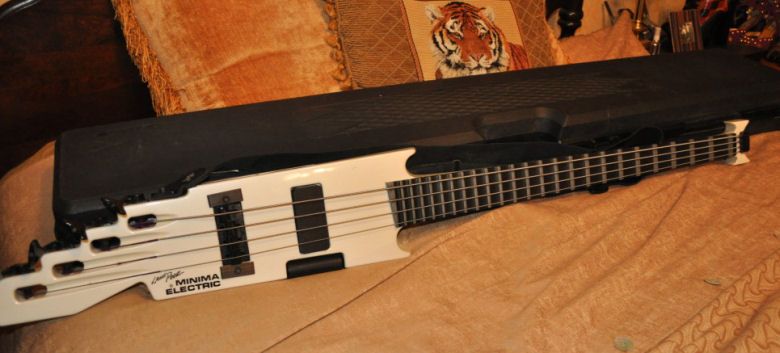 This Lane Poor Minima headless bass has a highly unusual style of fingerboard with "carbon glass" frets is again being offered for sale. If you missed our previous post about this very instrument last year, you can see it here.
This Lane Poor Minima headless bass has a highly unusual style of fingerboard with "carbon glass" frets is again being offered for sale. If you missed our previous post about this very instrument last year, you can see it here.
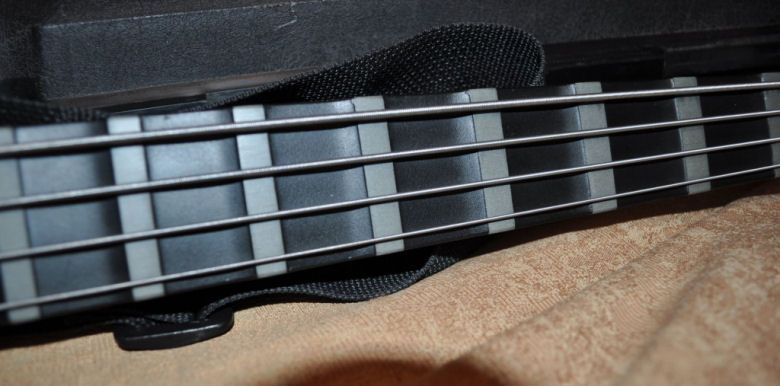 Currently listed on eBay with a Buy It Now price of $2,900.
Currently listed on eBay with a Buy It Now price of $2,900.
G L Wilson
Guitarz - The Original Guitar Blog - now in its 9th year!
 This Lane Poor Minima headless bass has a highly unusual style of fingerboard with "carbon glass" frets is again being offered for sale. If you missed our previous post about this very instrument last year, you can see it here.
This Lane Poor Minima headless bass has a highly unusual style of fingerboard with "carbon glass" frets is again being offered for sale. If you missed our previous post about this very instrument last year, you can see it here. Currently listed on eBay with a Buy It Now price of $2,900.
Currently listed on eBay with a Buy It Now price of $2,900.G L Wilson
Guitarz - The Original Guitar Blog - now in its 9th year!
Sunday 11 September 2011
Vintage Yamaha SG-12 twelve-string solidbody which has been rather disturbingly "customised"
guitarz.blogspot.com:
As a particular fan of these early Yamaha solidbody guitars, I do find the "customisation" carried out on this particular Yamaha SG-12 rather distressing. Not only has it been inexpertly painted gold (and with some meaningless name applied to the headstock for who knows what reason), but it is missing the original pickguard, pickups and electrics. The current pickguard is an ugly handcut affair, not helped in being a hefty quarter of an inch thick.
I only hope that whoever did this to such a fantastic old guitar, perhaps didn't have the guitar in a state of completeness to begin with (in which case, someone before must have messed it up).
This guitar is currently listed on eBay, and with one day left to go before the auction finishes the bidding is currently at £399. If this guitar was in original condition, I'd expect it to sell for at least $1000. There was recently another SG-12 on eBay which, alas, was incomplete - there were parts missing such as bridge saddles. That particular guitar sold quite cheaply. It'd be nice to think that whoever bought that one, could buy this example too and assemble a single Yamaha SG-12 as it should be and keep the rest as spares.
Anyway, here's what it SHOULD look like.
G L Wilson
[EDIT: The story of this guitar does not end here. Click here to see what happened next!]
© 2011, Guitarz - The Original Guitar Blog - now in its 10th year!
As a particular fan of these early Yamaha solidbody guitars, I do find the "customisation" carried out on this particular Yamaha SG-12 rather distressing. Not only has it been inexpertly painted gold (and with some meaningless name applied to the headstock for who knows what reason), but it is missing the original pickguard, pickups and electrics. The current pickguard is an ugly handcut affair, not helped in being a hefty quarter of an inch thick.
I only hope that whoever did this to such a fantastic old guitar, perhaps didn't have the guitar in a state of completeness to begin with (in which case, someone before must have messed it up).
This guitar is currently listed on eBay, and with one day left to go before the auction finishes the bidding is currently at £399. If this guitar was in original condition, I'd expect it to sell for at least $1000. There was recently another SG-12 on eBay which, alas, was incomplete - there were parts missing such as bridge saddles. That particular guitar sold quite cheaply. It'd be nice to think that whoever bought that one, could buy this example too and assemble a single Yamaha SG-12 as it should be and keep the rest as spares.
Anyway, here's what it SHOULD look like.
G L Wilson
[EDIT: The story of this guitar does not end here. Click here to see what happened next!]
© 2011, Guitarz - The Original Guitar Blog - now in its 10th year!
1967 Silvertone-branded Danelectro 1443 bass in red-black burst
guitarz.blogspot.com:
This 1967 Silvertone-branded Danelectro 1443 bass in red-black burst was made by the original Danelectro company in Neptune New Jersey in what would have been their final couple of years. Having moved away from guitars made as cheaply as possible (bodies were a crude pine frame sandwiched beteen two sheets of masonite), this dual liptsick pickup long-scale (34") bass is a proper solidbody instrument, a contender perhaps against the Fender Precision. The Silvertone brand (a name with which Danelectro is almost synonymous) on this bass means that it would have been sold through Sears, Roebuck and Company stores.
The example seen here is in excellent condition for its age and is currently listed on eBay with a starting price of $399.99 and a not unreasonable Buy It Now price of $779.99.
G L Wilson
© 2011, Guitarz - The Original Guitar Blog - now in its 10th year!
This 1967 Silvertone-branded Danelectro 1443 bass in red-black burst was made by the original Danelectro company in Neptune New Jersey in what would have been their final couple of years. Having moved away from guitars made as cheaply as possible (bodies were a crude pine frame sandwiched beteen two sheets of masonite), this dual liptsick pickup long-scale (34") bass is a proper solidbody instrument, a contender perhaps against the Fender Precision. The Silvertone brand (a name with which Danelectro is almost synonymous) on this bass means that it would have been sold through Sears, Roebuck and Company stores.
The example seen here is in excellent condition for its age and is currently listed on eBay with a starting price of $399.99 and a not unreasonable Buy It Now price of $779.99.
G L Wilson
© 2011, Guitarz - The Original Guitar Blog - now in its 10th year!
Saturday 10 September 2011
Vintage & Rare guitar of the week: Jeff Buckley's Telecaster
guitarz.blogspot.com:
Born in November 1966, Jeff Buckley was a critically acclaimed singer-songwriter who grew up in California and was son to legendary musician Tim Buckley. He spent a decade playing session guitar in Los Angeles and went on to create quite a following for himself playing at various venues in Manhattan's East Village, initially playing covers but gradually performing more and more of his own material. In 1994 he released what was to become his only studio album, Grace. The album was toured for two years before Buckley moved to Memphis, Tennessee, in 1997 with the intention to work on his second album, My Sweetheart the Drunk. However, while waiting for his band to turn up from New York, Buckley took a swim in the Wolf River and, getting caught in the wake of a boat, was tragically drowned. Like his father before him, he died far too young.
Buckley used quite a few guitars including a Rickenbacker 360/12, Gibson Les Paul Custom "Black Beauty", Fender Jaguar and others, but his main guitar was this 1983 Fender Telecaster in faded butterscotch finish with chrome pickguard and Seymour Duncan Hot Lead Stack STK-T2b pickup in the bridge position.
This very guitar is being offered for sale via our friends at Vintage & Rare, priced at €42,600 / USD $60,000.
Photos courtesy of Vintage & Rare.
G L Wilson
© 2011, Guitarz - The Original Guitar Blog - now in its 10th year!
Born in November 1966, Jeff Buckley was a critically acclaimed singer-songwriter who grew up in California and was son to legendary musician Tim Buckley. He spent a decade playing session guitar in Los Angeles and went on to create quite a following for himself playing at various venues in Manhattan's East Village, initially playing covers but gradually performing more and more of his own material. In 1994 he released what was to become his only studio album, Grace. The album was toured for two years before Buckley moved to Memphis, Tennessee, in 1997 with the intention to work on his second album, My Sweetheart the Drunk. However, while waiting for his band to turn up from New York, Buckley took a swim in the Wolf River and, getting caught in the wake of a boat, was tragically drowned. Like his father before him, he died far too young.
Buckley used quite a few guitars including a Rickenbacker 360/12, Gibson Les Paul Custom "Black Beauty", Fender Jaguar and others, but his main guitar was this 1983 Fender Telecaster in faded butterscotch finish with chrome pickguard and Seymour Duncan Hot Lead Stack STK-T2b pickup in the bridge position.
This very guitar is being offered for sale via our friends at Vintage & Rare, priced at €42,600 / USD $60,000.
Photos courtesy of Vintage & Rare.
G L Wilson
© 2011, Guitarz - The Original Guitar Blog - now in its 10th year!
Peavey Mantis, another pointy 1980s Made In The USA guitar from Peavey
guitarz.blogspot.com:
A few days ago we looked at a Peavey Razer from 1983, which drew mixed comments from Guitarz readers. The only real criticism that made sense to me was that the shape lacked forearm support for the picking hand. Now that isn't a complaint that could be levelled at the contemporaneous Peavey Mantis, pictured here. The Mantis' body design draws together elements of Gibson's Flying V and Explorer models and marries them to a Strat-like maple bolt-on neck. It has a single beefy humbucker in the bridge position (hey, what else would you need on a guitar so obviously intended to appeal to the metal market?) and a Strat-like tremolo.
This example is being offered for sale on eBay with a very reasonable $259.99 Buy It Now price. OK, it's not a top of the line Peavey, but where else are you going to get a 1980s American-made guitar for that kind of money?
G L Wilson
© 2011, Guitarz - The Original Guitar Blog - now in its 10th year!
A few days ago we looked at a Peavey Razer from 1983, which drew mixed comments from Guitarz readers. The only real criticism that made sense to me was that the shape lacked forearm support for the picking hand. Now that isn't a complaint that could be levelled at the contemporaneous Peavey Mantis, pictured here. The Mantis' body design draws together elements of Gibson's Flying V and Explorer models and marries them to a Strat-like maple bolt-on neck. It has a single beefy humbucker in the bridge position (hey, what else would you need on a guitar so obviously intended to appeal to the metal market?) and a Strat-like tremolo.
This example is being offered for sale on eBay with a very reasonable $259.99 Buy It Now price. OK, it's not a top of the line Peavey, but where else are you going to get a 1980s American-made guitar for that kind of money?
G L Wilson
© 2011, Guitarz - The Original Guitar Blog - now in its 10th year!
Friday 9 September 2011
1978 Fender Jazz Bass with "love it or hate it" Antigua finish
guitarz.blogspot.com:
I'm not sure how many Fender Jazz Basses were produced n Antigua finish, although I know I have seen one before. I'm personally quite a fan of Fender's antigua finish, although I know many people detest it. I quite like the way that the "burst" effect is carried out also on the pickguard.
The antigua finish originally appeared in 1966, and was apparently serendipitous in that it was designed to hide a bodged finishing job. It then reappeared in the late 1970s and again in 2006 via Fender Japan. I briefly had one of the antigua Fender Japan Strats but thought the colour was too green and not "mushroom"-like enough for my tastes.
The above-pictured 1978 Fender Jazz Bass in antigua finish is currently being offered for sale on eBay with a hefty Buy It Now price of $3,088.
G L Wilson
© 2011, Guitarz - The Original Guitar Blog - now in its 10th year!
I'm not sure how many Fender Jazz Basses were produced n Antigua finish, although I know I have seen one before. I'm personally quite a fan of Fender's antigua finish, although I know many people detest it. I quite like the way that the "burst" effect is carried out also on the pickguard.
The antigua finish originally appeared in 1966, and was apparently serendipitous in that it was designed to hide a bodged finishing job. It then reappeared in the late 1970s and again in 2006 via Fender Japan. I briefly had one of the antigua Fender Japan Strats but thought the colour was too green and not "mushroom"-like enough for my tastes.
The above-pictured 1978 Fender Jazz Bass in antigua finish is currently being offered for sale on eBay with a hefty Buy It Now price of $3,088.
G L Wilson
© 2011, Guitarz - The Original Guitar Blog - now in its 10th year!
Spot the difference: Martin F-65 hollowbody electric and Japanese clone
guitarz.blogspot.com:
Further to our recent post about the Martin GT-70 hollowbody electric, pictured above at the top of the photo montage is another slightly better known electric guitar from the company known for their high-end acoustics, namely the Martin F-65. We have looked at this model previously here on Guitarz; it was produced between 1962 and 1965 (the example pictured is from 1964) and approximately 1,800 were made.
Whilst not as rare as the GT-70 the F-65 is still considered to be reasonably rare and is a desireable model today. This particular example is currently being offered for sale on eBay with a Buy It Now price of $2999.
Contrast this with the near identical looking guitar at the bottom of the photo montage. This is also currently listed on eBay but has a Buy It Now price of a very resaonable sounding $325. This guitar is actually a Japanese copy of the Martin F-65 and carries the St Moritz brandname. This copy is probably even rarer than the real thing, but as I have explained before, rare does not necessarily mean valuable.
Placed side by side you will notice some discrepancies. Hardware - pickups, bridge, vibrato - are obvious candidates for difference, but there are other minor differences such as the slightly over-sized f-holes and pickguard on the Japanese copy. The most obvious difference that is not apparent from the photos I have used here (so you will have to take my word for it) is that whilst the original Martin guitar has a glued-in set neck, the copy has a bolt-on neck.
I'm sure that with the Martin's set neck and DeArmond Dynasonic pickups that it's going to be the better sounding and playing of the two (and costing so much more I should think so too) but it would still be fun to get them both together and do a comparison.
See also this Japanese-made Zenta hollowbody bass which also freely borrows from the Martin F-65 desgin..
G L Wilson
© 2011, Guitarz - The Original Guitar Blog - now in its 10th year!
Further to our recent post about the Martin GT-70 hollowbody electric, pictured above at the top of the photo montage is another slightly better known electric guitar from the company known for their high-end acoustics, namely the Martin F-65. We have looked at this model previously here on Guitarz; it was produced between 1962 and 1965 (the example pictured is from 1964) and approximately 1,800 were made.
Whilst not as rare as the GT-70 the F-65 is still considered to be reasonably rare and is a desireable model today. This particular example is currently being offered for sale on eBay with a Buy It Now price of $2999.
Contrast this with the near identical looking guitar at the bottom of the photo montage. This is also currently listed on eBay but has a Buy It Now price of a very resaonable sounding $325. This guitar is actually a Japanese copy of the Martin F-65 and carries the St Moritz brandname. This copy is probably even rarer than the real thing, but as I have explained before, rare does not necessarily mean valuable.
Placed side by side you will notice some discrepancies. Hardware - pickups, bridge, vibrato - are obvious candidates for difference, but there are other minor differences such as the slightly over-sized f-holes and pickguard on the Japanese copy. The most obvious difference that is not apparent from the photos I have used here (so you will have to take my word for it) is that whilst the original Martin guitar has a glued-in set neck, the copy has a bolt-on neck.
I'm sure that with the Martin's set neck and DeArmond Dynasonic pickups that it's going to be the better sounding and playing of the two (and costing so much more I should think so too) but it would still be fun to get them both together and do a comparison.
See also this Japanese-made Zenta hollowbody bass which also freely borrows from the Martin F-65 desgin..
G L Wilson
© 2011, Guitarz - The Original Guitar Blog - now in its 10th year!
Thursday 8 September 2011
Guild S30 3/4 - rare three-quarter scale solidbody from 1979
guitarz.blogspot.com:
In 1977, Guild introduced the S60 guitar series of solidbody electric guitars, a line of instruments which were in production until the early 1980s. The S60 itself had a single humbucker, whereas the S60 D intially had dual humbuckers on earlier models, and dual P90s on later models.
Picured above is a rarer Guild S60 3/4 from 1979, which as the model designation suggests is a 3/4-scale version of the standard S60; a "Mini Me" version, if you will. Whether this was intended as a younger player's guitar, for those of a smaller stature, etc, or whether it was to enable the player to use higher tunings, e.g. a fifth above standard, I don't know.
G L Wilson
© 2011, Guitarz - The Original Guitar Blog - now in its 10th year!
In 1977, Guild introduced the S60 guitar series of solidbody electric guitars, a line of instruments which were in production until the early 1980s. The S60 itself had a single humbucker, whereas the S60 D intially had dual humbuckers on earlier models, and dual P90s on later models.
Picured above is a rarer Guild S60 3/4 from 1979, which as the model designation suggests is a 3/4-scale version of the standard S60; a "Mini Me" version, if you will. Whether this was intended as a younger player's guitar, for those of a smaller stature, etc, or whether it was to enable the player to use higher tunings, e.g. a fifth above standard, I don't know.
G L Wilson
© 2011, Guitarz - The Original Guitar Blog - now in its 10th year!
1979 Gibson ES-175CC Charlie Christian with rail pickup
Always had a soft spot for hollow body archtops with florentine cutaway (not the budget though), and you cannot do better than the Gibson ES-175 (well yes actually, you could do better by avoiding sunburst finish), but watching at this 1979 Charlie Christian model, I realize that I've always associated rail pickups with loud guitars exclusively aimed at 1990s metal - and almost always see them doubled in humbuckers (or even quadrupled in double humbuckers).
So I wasn't aware that this elegant one rail pickup in hexagonal art deco casing to which bebop/pre-cool jazz guitar player Charlie Christian gave his name is actually one of the first modern pickups, introduced in 1936 and replacing the previous horseshoe magnet pickup created by Rickenbacker. It equipped the first ES (Electric Spanish) Gibson model - the ES-150 - and allowed Christian to more or less invent guitar soloing due to its louder output. Replaced by subtler six poles pickups, it was reintroduced in 1978 for this ES-175 that is not a signature model of course since Christian passed in 1942, but a tribute.
You will find more information on Charlie Christian pickups here.
Bertram
© 2011, Guitarz - The Original Guitar Blog - now in its 10th year!
Wednesday 7 September 2011
Peavey Razer, made in USA, 1983-1986
guitarz.blogspot.com:
Grégory writes:
G L Wilson
© 2011, Guitarz - The Original Guitar Blog - now in its 10th year!
Grégory writes:
Am I wrong, or is it real that you never had a post on your great website about the wonderful Peavey Razer guitar from the early eighties? The shape is supposed to replicate a razor, all I know is that it's really intriguing, innovative and well done.Thanks Grégory. We always enjoy seeing pictures and hearing about readers' guitars. Please keep them coming in!
I own one of these, built in 1983, according to the serial number. It's like a brand new unit, with some really nice ideas in it: vertical holes on the surface of the mechanics [machine heads? - GLW], so you can "plug" the string in it before you start rolling (simple idea, great improvement!), neck has no board but it is built in 2 parts of wood so it stay straight (truss rod inside anyway), Single Coil / Humbucker switch when turning down the tone knobs (you reach 7, humbucker kicks in), the bridge is in plain metal so very solid. I'm sure the guitar could survive a nuclear disaster.
G L Wilson
© 2011, Guitarz - The Original Guitar Blog - now in its 10th year!
Subscribe to:
Posts (Atom)

